ICOM orporated 288000 Communications Receiver User Manual IC R1500
ICOM Incorporated Communications Receiver IC R1500
Contents
- 1. User Manual 1
- 2. User Manual 2
User Manual 1

INSTRUCTION MANUAL
New2001
iR1500
COMMUNICATIONS RECEIVER
This device complies with Part 15 of the FCC rules. Operation is sub-
ject to the following two conditions: (1) This device may not cause
harmful interference, and (2) this device must accept any interference
received, including interference that may cause undesired operation.
! IC-R1500.qxd 05.10.21 10:07 AM Page A (1,1)
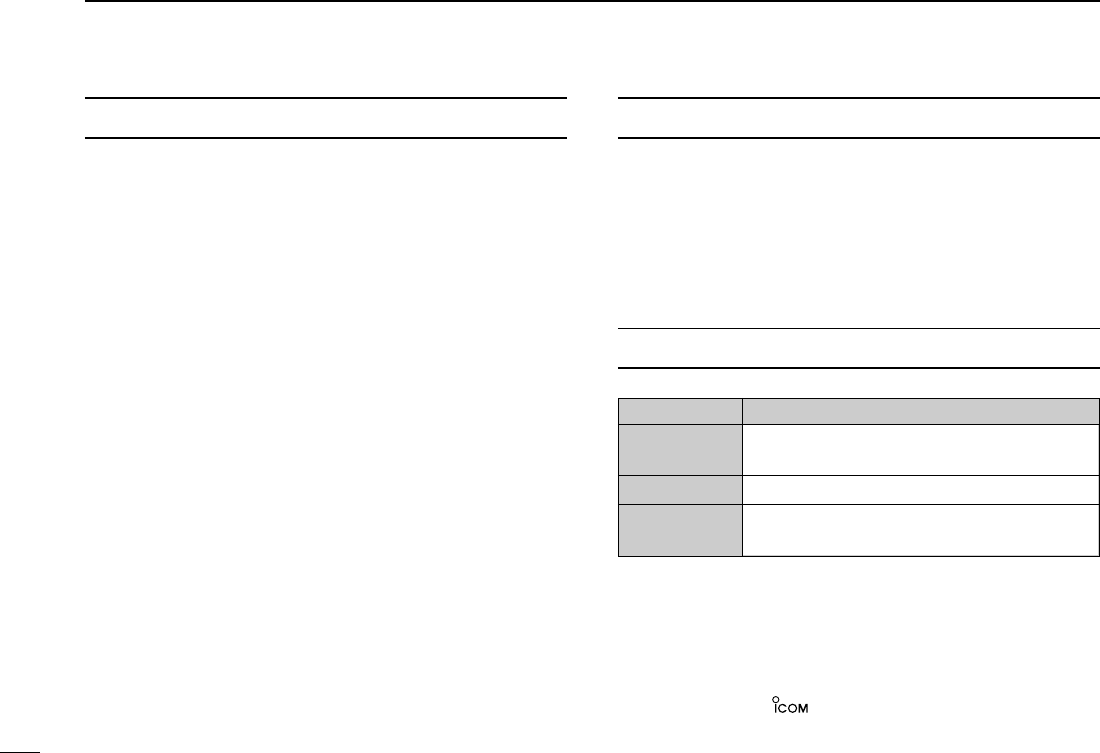
i
New2001
FOREWORD
Thank you for purchasing this Icom product. The IC-R1500
COMMUNICATIONS RECEIVER
is designed and built with Icom’s
state of the art technology and craftsmanship. With proper care,
this product should provide you with years of trouble-free oper-
ation.
We want to take a couple of moments of your time to thank
you for making your IC-R1500 your radio of choice, and hope
you agree with Icom’s philosophy of “technology first.” Many
hours of research and development went into the design of
your IC-R1500.
DD
FEATURES
❍Wide frequency coverage with all mode re-
ceive
❍Real-time bandscope function
❍IF shift function function
❍
ANF and NR functions available (Only when
the DSP unit is installed.)
IMPORTANT
READ ALL INSTRUCTIONS carefully and completely
before using the receiver.
SAVE THIS INSTRUCTION MANUAL— This in-
struction manual contains important operating instructions for
the IC-R1500.
EXPLICIT DEFINITIONS
WORD DEFINITION
RWARNING!
CAUTION
NOTE
Personal injury, fire hazard or electric shock
may occur.
Equipment damage may occur.
Recommended for optimum use. No risk of
personal injury, fire or electric shock.
Icom, Icom Inc. and the logo are registered trademarks of Icom Incor-
porated (Japan) in the United States, the United Kingdom, Germany, France,
Spain, Russia and/or other countries.
! IC-R1500.qxd 05.10.21 10:07 AM Page i (1,1)
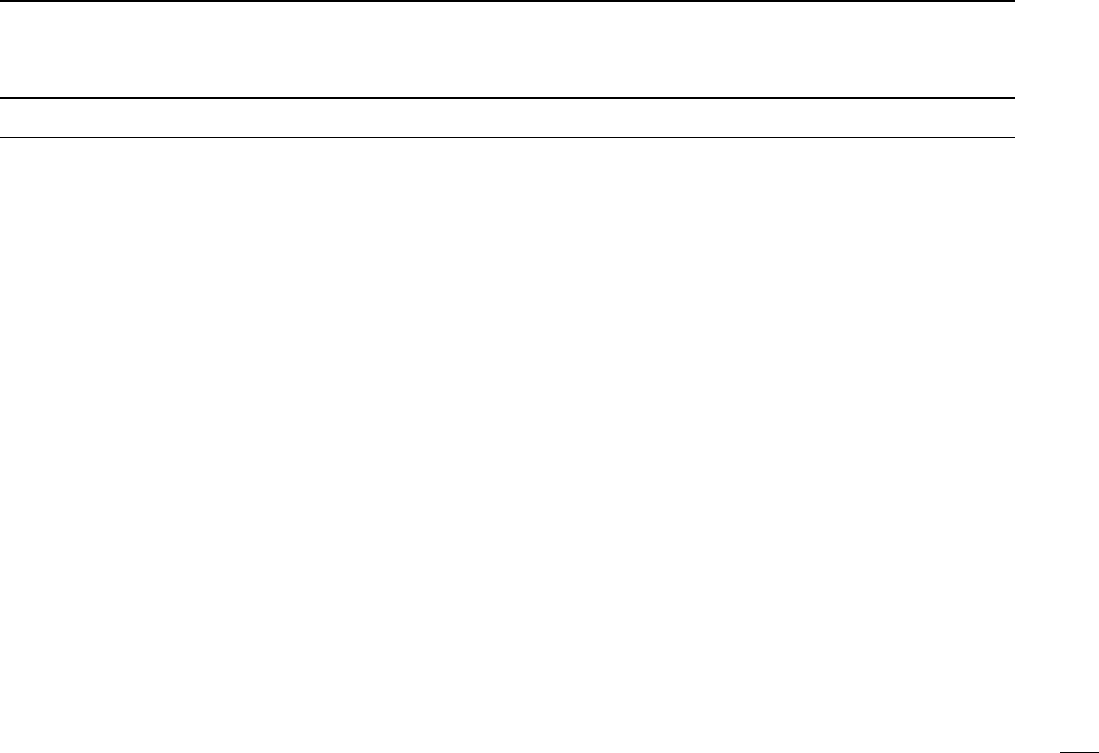
ii
New2001
RWARNING RF EXPOSURE! This device emits Radio
Frequency (RF) energy. Extreme caution should be observed when
operating this device. If you have any questions regarding RF expo-
sure and safety standards please refer to the Federal Communica-
tions Commission Office of Engineering and Technology’s report on
Evaluating Compliance with FCC Guidelines for Human Radio fre-
quency Electromagnetic Fields (OET Bulletin 65).
RWARNING! NEVER connect the receiver to an AC outlet.
This may pose a fire hazard or result in an electric shock.
RWARNING! NEVER operate the receiver while driving a
vehicle. Safe driving requires your full attention—anything less may
result in an accident.
NEVER connect the receiver to a power source of more than 16 V
DC. This will damage the receiver.
NEVER connect the receiver to a power source using reverse po-
larity. This will damage the receiver.
NEVER cut the DC power cable between the DC plug and fuse
holder. If an incorrect connection is made after cutting, the receiver
may be damaged.
NEVER expose the receiver to rain, snow or any liquids. The re-
ceiver may be damaged.
NEVER operate or touch the receiver with wet hands. This may
result in an electric shock or damage the receiver.
NEVER place the receiver where normal operation of the vehicle
may be hindered or where it could cause bodily injury.
NEVER let objects impede the operation of the cooling fan on the
rear panel.
AVOID using or placing the receiver in direct sunlight or in areas
with temperatures below –10°C (+14°F) or above +60°C (+140°F).
BE CAREFUL! The receiver will become hot when operating it
continuously for long periods.
AVOID setting the receiver in a place without adequate ventilation.
Heat dissipation may be affected, and the receiver may be damaged.
AVOID the use of chemical agents such as benzine or alcohol
when cleaning, as they can damage the receiver’s surfaces.
USE Icom microphones only (supplied or optional). Other manu-
facturer’s microphones have different pin assignments and may dam-
age the receiver if attached.
For U.S.A. only
CAUTION: Changes or modifications to this device, not ex-
pressly approved by Icom Inc., could void your authority to
operate this device under FCC regulations.
PRECAUTION
! IC-R1500.qxd 05.10.21 10:07 AM Page ii (1,1)

iii
New2001
TABLE OF CONTENTSSUPPLIED ACCESSORIES
qAntenna ………………………………………………………1
wAC adapter …………………………………………………1
eUSB cable …………………………………………………1
rCD ……………………………………………………………1
tLeg pad ………………………………………………………1
FOREWORD ........................................................................................... i
IMPORTANT ............................................................................................ i
EXPLICIT DEFINITIONS ......................................................................... i
PRECAUTION ........................................................................................ ii
SUPPLIED ACCESSORIES .................................................................. iii
TABLE OF CONTENTS ......................................................................... iii
QUICK REFERENCE GUIDE ............................................................. I–X
■Installation ....................................................................................... I
■Your first contact .......................................................................... VII
■Repeater operation ....................................................................... IX
■Programming memory channels..................................................... X
1 PANEL DESCRIPTION ................................................................. 1–5
■Front panel— controller ................................................................. 1
■Function display ............................................................................. 3
■Rear panel ..................................................................................... 5
2 SETTING A FREQUENCY ............................................................ 6–8
■Turning power ON/OFF ................................................................. 6
■Mode selection ............................................................................... 6
■Tuning step selection ..................................................................... 7
■Setting a frequency ........................................................................ 7
■Receive mode selection ................................................................. 8
■Lock function .................................................................................. 8
3 BASIC OPERATION ................................................................... 9–11
■Receiving ....................................................................................... 9
■Monitor function ............................................................................. 9
■Squelch attenuator ....................................................................... 10
■AFC function ................................................................................ 10
■NB function ................................................................................... 11
■AGC function ................................................................................ 11
■VSC function ................................................................................ 11
! IC-R1500.qxd 05.10.21 10:07 AM Page iii (1,1)
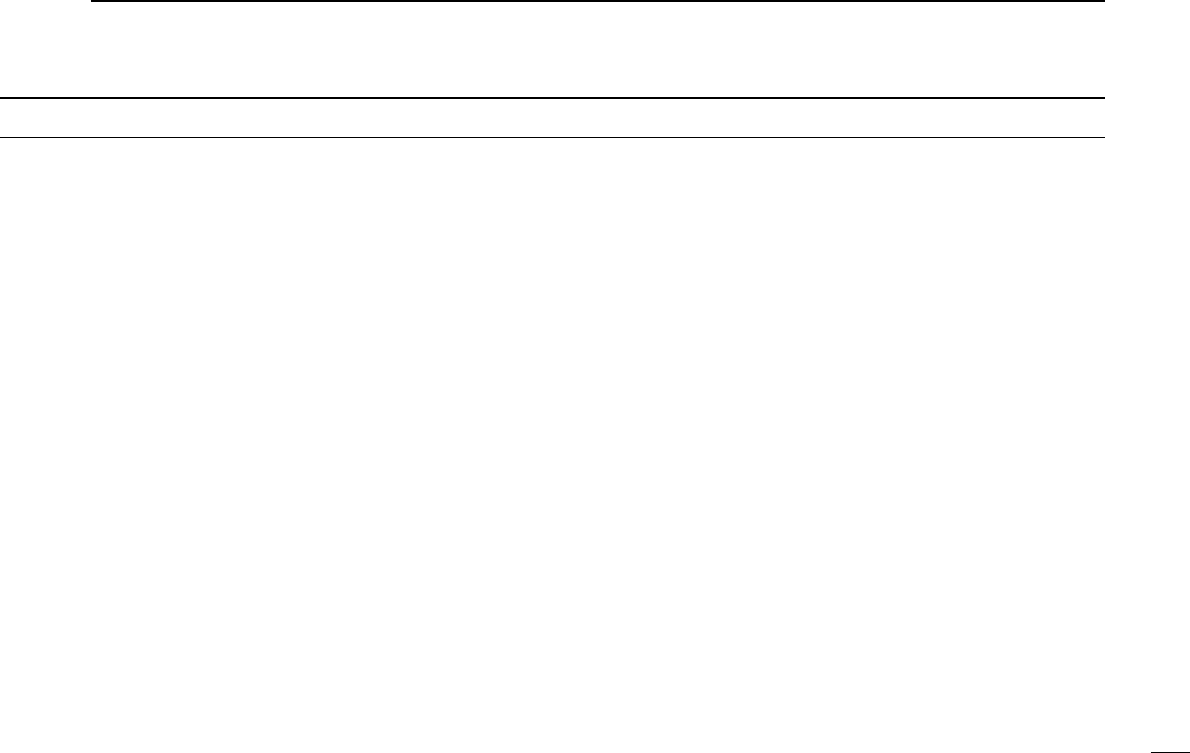
iv
New2001
4 MEMORY OPERATION ............................................................ 12–19
■General description ...................................................................... 12
■Memory channel selection ........................................................... 12
■Programming a memory channel ................................................. 13
■Programming channel names ..................................................... 14
■Copying memory contents ........................................................... 16
■Memory clearing .......................................................................... 17
■Memory bank selection ................................................................ 18
■Memory bank setting .................................................................... 18
■Transferring bank contents .......................................................... 19
5 SCAN OPERATION .................................................................. 20–24
■Scan types ................................................................................... 20
■Scan start/stop ............................................................................. 21
■Scan edges programming ............................................................ 22
■Skip channel/frequency setting .................................................... 23
■Scan resume condition ................................................................ 24
6 PRIORITY WATCH .......................................................................... 25
■Priority watch types ...................................................................... 25
■Priority watch operation ............................................................... 25
7 POCKET BEEP AND TONE SQUELCH ................................... 26–28
■Pocket beep operation ................................................................. 26
■Tone/DTCS squelch operation ..................................................... 27
■Tone scan ..................................................................................... 28
8 SET MODE ................................................................................ 29–35
■General ........................................................................................ 29
■Set mode items ............................................................................ 29
9 SPECIFICATIONS AND OPTIONS ........................................... 37–39
■Specifications ............................................................................... 37
■Options ......................................................................................... 39
■AM/FM narrow mode ................................................................... 65
■Weather channel operation (USA version only) ........................... 66
■Microphone keys .......................................................................... 67
■Partial reset .................................................................................. 68
■All reset ........................................................................................ 68
■Data cloning ................................................................................. 69
■Packet operation .......................................................................... 71
12 MAINTENANCE ........................................................................ 75–76
■Troubleshooting ........................................................................... 75
■Fuse replacement ........................................................................ 76
9 SPECIFICATIONS AND OPTIONS ........................................... 37–39
■Specifications ............................................................................... 37
■Options ......................................................................................... 39
14 MODE ARRANGEMENT ........................................................... 79–80
! IC-R1500.qxd 05.10.21 10:07 AM Page iv (1,1)
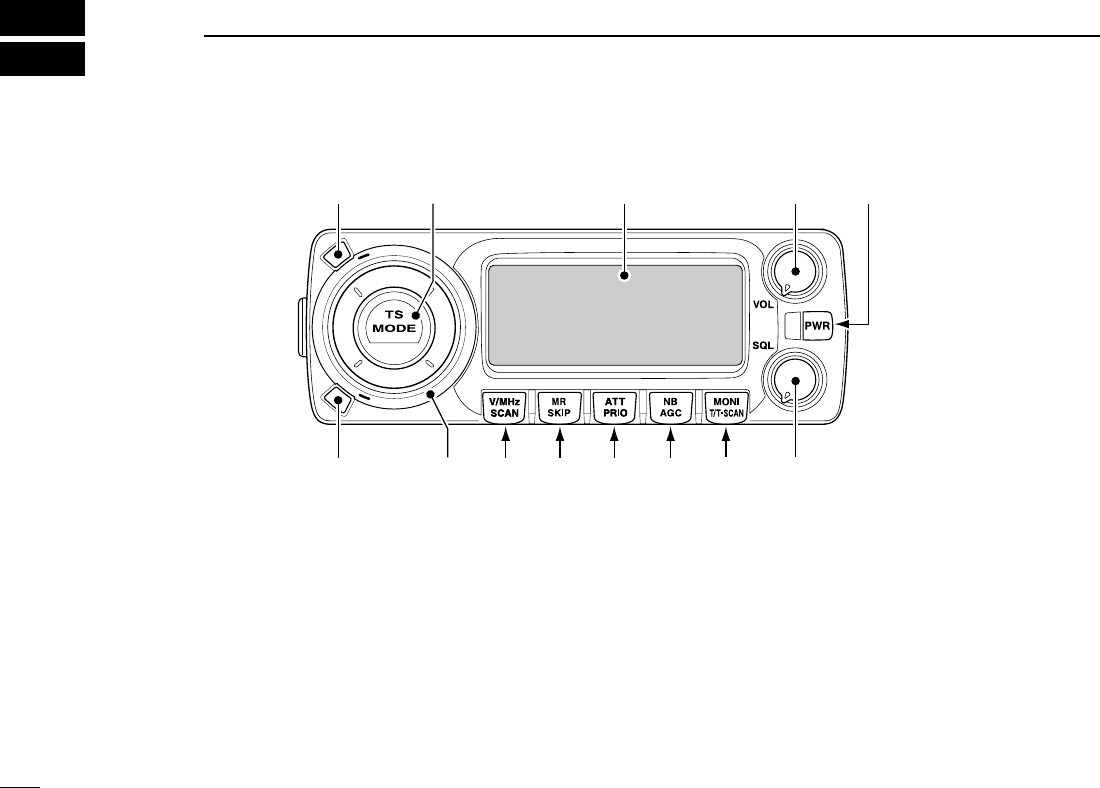
1
PANEL DESCRIPTION
New2001
1
■Front panel— controller
qSET•LOCK SWITCH [SET•LOCK]
➥Enters set mode when pushed. (p. ??)
➥Switches the lock function ON and OFF when pushed
for 1 sec. (p. ??)
wTUNING STEP/MODE [TS•MODE]
➥Push to select the tuning step. (p. ??)
➥Each push for 1 sec. selects the operating mode. (p. ??)
eVOLUME CONTROL [VOL] (p. ??)
Adjusts the audio level.
rPOWER SWITCH FOR CONTROLLER [PWR]
Turns the controller power ON and OFF when pushed for
1 sec.
tSQUELCH CONTROL [SQL]
Varies the squelch level. (p. ??)
yMONITOR•TONE•TONE SCAN SWITCH
[MONI•T/T-SCAN]
➥Push to switch the monitor function ON and OFF. (p. ??)
➥Push for 1 sec. to enter the tone function selection
mode. (pgs. ??, ??)
• Subaudible tone encoder, pocket beep (CTCSS), tone
squelch, pocket beep (DTCS), DTCS squelch or tone func-
tion OFF can be selected.
➥Push for 1 sec. during tone function selection mode to
start the tone scan. (p. ??)
S
E
T
L
O
C
K
S
.
M
W
M
W
rewq
!2 !1 !0 oi uy t
Function display (☞p. ??)
! IC-R1500.qxd 05.10.21 10:07 AM Page 1 (1,1)

2
11
PANEL DESCRIPTION
New2001
1
2
3
4
5
6
7
8
9
10
11
12
13
14
15
16
uNOISE BLANKER/AUTOMATIC GAIN CONTROL
SWITCH [NB•AGC]
➥Push to switch the NB (Noise Blanker) function ON and
OFF. (p. ??)
• The noise blanker function cannot be used in WFM mode.
➥Push for 1 sec. to switch the AGC (Automatic Gain Con-
trol) function ON and OFF. (p. ??)
iATTENUATOR/PRIORITY SWITCH [ATT•PRIO]
➥Push to switch the ATT (Attenuator) function ON and
OFF. (p. ??)
➥Starts priority watch when pushed for 1 sec. (p. ??)
oMEMORY/SKIP SWITCH [MR•SKIP]
➥Push to select and toggle memory and weather chan-
nel* modes. (pgs. ??, ??, ??)
*Weather channels are available for USA version only.
➥Push for 1 sec. to turn the channel skip setting ON and
OFF for memory skip scan operation. (p. ??)
!0 VFO/MHz TUNING•SCAN SWITCH [V/MHz•SCAN]
➥Selects and toggles VFO mode and 1 MHz (or 10 MHz
for some versions) tuning when pushed. (p. ??)
➥Starts scan when pushed for 1 sec. (p. ??)
• Cancels a scan when pushed during scan.
!1 TUNING DIAL [DIAL]
Selects the operating frequency (p. ??), memory channel
(p. ??), the setting of the set mode item and the scanning
direction (p. ??).
!2 MEMORY WRITE SWITCH [S.MW•MW] (pgs. ??, ??, ??)
➥Selects a memory channel for programming when
pushed.
➥Programs the selected memory channel when pushed
for 1 sec.
!3 POWER SWITCH FOR RECEIVER [POWER]
Turns the receiver power ON and OFF
! IC-R1500.qxd 05.10.21 10:07 AM Page 2 (1,1)
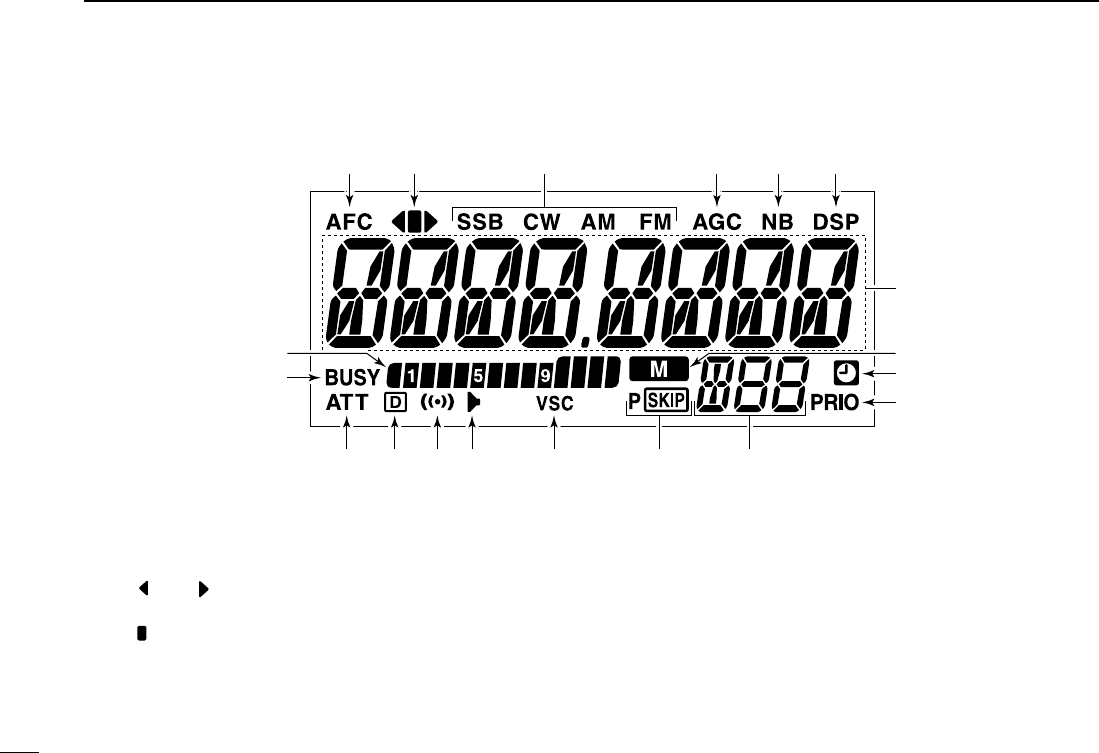
3
1PANEL DESCRIPTION
New2001
■Function display
qAFC INDICATOR
Appears when the AFC function is in use. (p. ??)
wFM CENTER INDICATORS (p. ??)
➥“ ” or “ ” appears when the received signal is not
tuned to its center frequency; or the squelch is closed.
➥“ ” appears when the received signal is tuned to its
center frequency.
eRECEIVE MODE INDICATORS
Shows the selected receive mode.
• LSB, USB, CW, AM, FM and WFM are available.
rAGC INDICATOR (p. ??)
Appears when the AGC function in use. (p. ??)
tNB INDICATOR (p. ??)
Appears when the NB function is in use. (p. ??)
yDSP INDICATOR (p. ??)
Appears when the DSP digital filter function is in use.
e r t yq w
!7 !6 !5 !4 !3
o
!0
u
!8
!2 !1
i
!9
! IC-R1500.qxd 05.10.21 10:07 AM Page 3 (1,1)
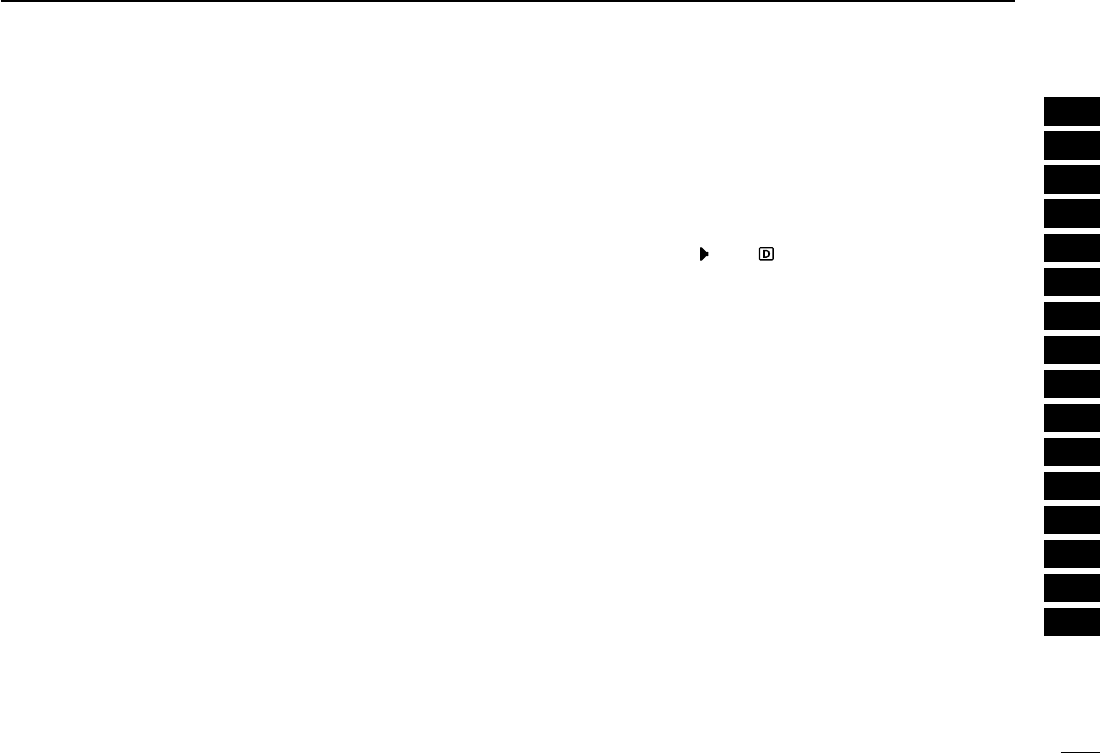
4
1
PANEL DESCRIPTION
New2001
1
2
3
4
5
6
7
8
9
10
11
12
13
14
15
16
uFREQUENCY READOUT
Shows the operating frequency, channel names, set mode
contents, etc.
• Frequency decimal point blinks while scanning. (p. ??)
• “d” appears in place of the 1st digit while the DTMF memory
function is in use. (p. ??)
iMEMORY INDICATOR (pgs. ??, ??)
Appears when memory mode is selected.
oAUTO POWER-OFF INDICATOR (p. ??)
Appears while the auto power OFF function is in use.
!0PRIORITY INDICATOR (p. ??)
Appears while the priority watch is activated; blinks while
the watch is paused.
!1MEMORY CHANNEL NUMBER INDICATORS
➥Shows the selected memory channel number. (p. ??)
➥Shows the selected bank initial. (p. ??)
➥“L” appears when the lock function is activated. (p. ??)
!2SKIP INDICATORS (p. ??)
➥“~” appears when the displayed memory channel is
specified as a skip channel.
➥“P ~” appears when the displayed frequency is spec-
ified as a program skip frequency.
!3VSC INDICATOR (p. ??)
Appears when the VSC function is in use. (p. ??)
!4TONE SQUELCH INDICATOR (p. ??)
Appears when the tone squelch function is in use. (p. ??)
!5POKET BEEP INDICATOR (p. ??)
➥Appears when the poket beep function is in use. (p. ??)
➥Appears with “ ” or “ ” while the pocket beep func-
tion (with CTCSS or DTCS) is in use. (p. ??)
!6DTCS SQUELCH INDICATOR (p. ??)
Appears while the DTCS squelch function is in use. (p. ??)
!7ATT INDICATOR (p. ??)
Appears when the ATT function is in use. (p. ??)
!8BUSY INDICATOR
➥Appears when a signal is being received or the squelch
is open. (p. ??)
➥Blinks while the monitor function is in use. (p. ??)
!9S-METER INDICATORS
Shows the relative signal strength while receiving signals.
(p. ??)
! IC-R1500.qxd 05.10.21 10:07 AM Page 4 (1,1)
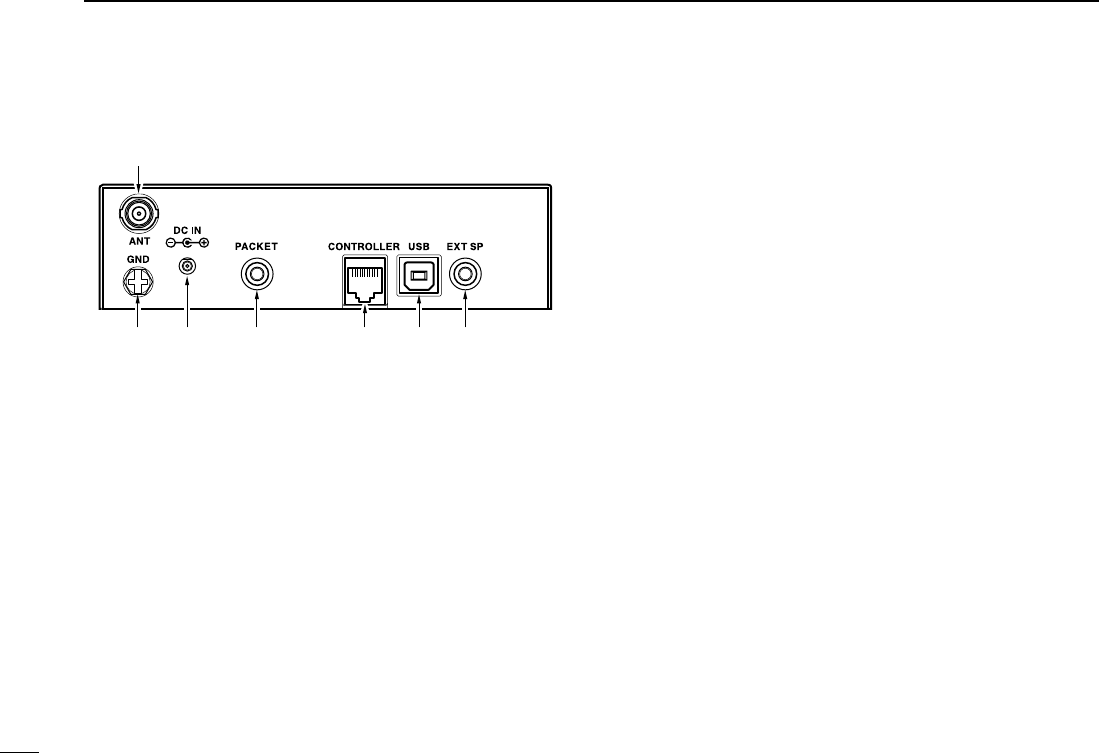
5
1PANEL DESCRIPTION
New2001
■Rear Panel
qANTENNA CONNECTOR [ANT]
Connects a 50 Ωantenna with a BNC connector and a 50
Ωcoaxial cable.
wEXTERNAL SPEAKER JACK [EXT SP]
Connects an 8 Ωexternal speaker.
• Audio output power is more than 0.5 W.
eUSB RECEPTACLE [USB]
Connects to a PC via an extension cable.
rCONTROLLER [CONTROLLER]
Connects to a controller via an extension cable.
tDATA SOCKET [PACKET]
Connects a TNC (Terminal Node Controller), etc. for data
communications. The receiver can receive 9600 bps
packet communication (AFSK.)
• See p. ? for connection information.
yPOWER RECEPTACLE [DC IN]
Accepts 12 V DC ±15% with the supplied DC power cable.
☞NOTE: DO NOT use a cigarette lighter socket as a
power source when operating in a vehicle. The plug
may cause voltage drops and ignition noise may be su-
perimposed onto receive audio.
uGROUND TERMIAL [GND]
Connect this terminal to a ground.
q
uy t r ew
! IC-R1500.qxd 05.10.21 10:07 AM Page 5 (1,1)
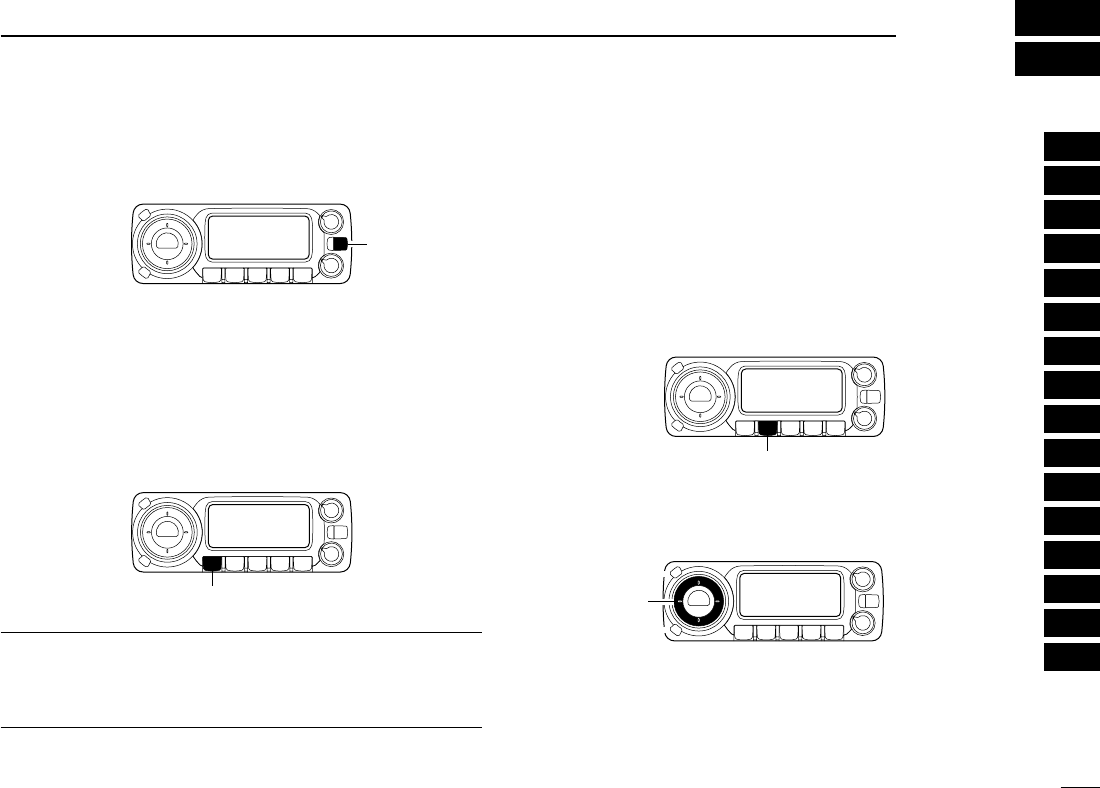
6
2
SETTING A FREQUENCY
1
2
3
4
5
6
7
8
9
10
11
12
13
14
15
16
■Turning power ON/OFF
➥Push [PWR] for 1 sec. to turn power ON and OFF.
■Mode selection
DVFO modes
VFO mode is used for the desired frequency setting within the
frequency coverage.
➥Push [V/MHz•SCAN] to select VFO mode.
What is VFO?
VFO is an abbreviation of Variable Frequency Oscillator. Fre-
quencies for receiving are generated and controlled by the
VFO.
DMemory mode/Weather channels*
Memory mode is used for operation of memory channels
which have programmed frequencies. Weather channels* are
monitored each 5 sec. when the weather alert function is
turned ON.
*Available for the USA version only.
qPush [MR•SKIP] several times to select the channel type.
• Memory mode/Weather channels can be selected in sequence.
•“!” indicator appears when memory mode is selected.
wRotate [DIAL] to select the desired channel.
• Only programmed memory channels can be selected.
• See p. ?? for memory programming details.
[DIAL]
[MR•SKIP]
[V/MHz•SCAN]
[PWR]
! IC-R1500.qxd 05.10.21 10:07 AM Page 6 (1,1)
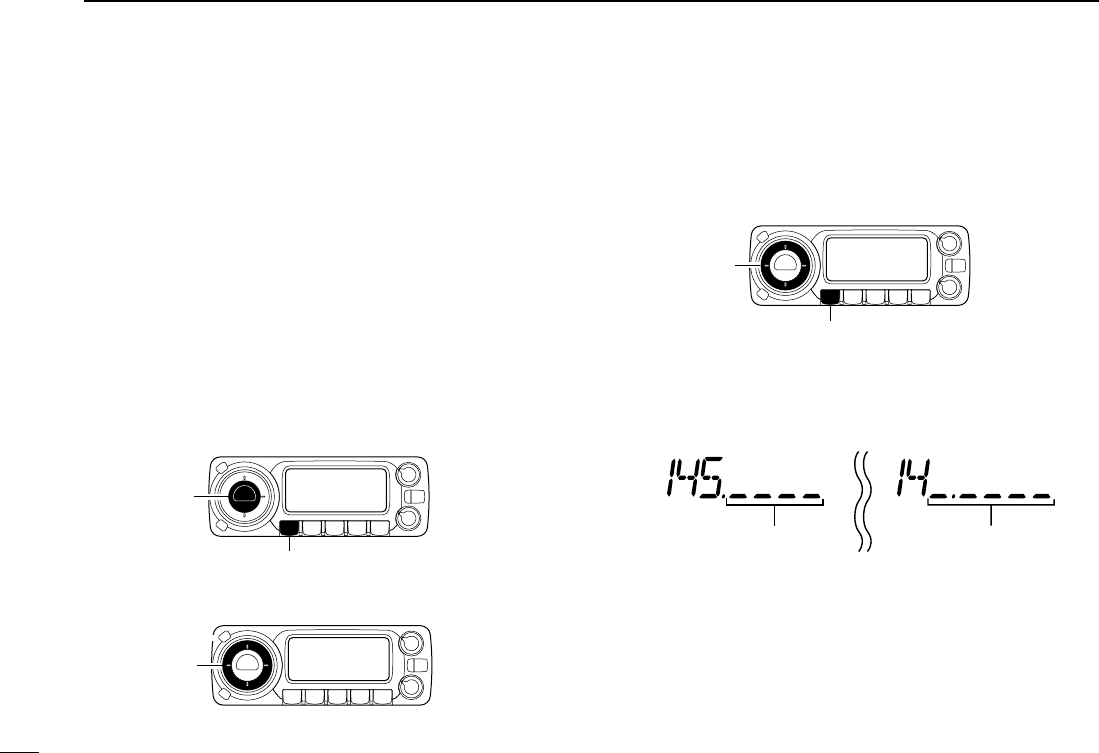
7
2SETTING A FREQUENCY
New2001
■Tuning step selection
When using the tuning dial to change the frequency, or when
a scan function is activated, the frequency changes in incre-
ments determined by the set tuning step. This can be
changed if desired.
The following tuning step are available.
• 1 Hz • 10Hz • 20 Hz • 50 Hz • 100 Hz
• 500Hz • 1 kHz • 2.5 kHz • 5 kHz • 6.25 kHz
• 8.33 kHz • 9 kHz • 10 kHz • 12.5 kHz • 15 kHz
• 20 kHz • 25 kHz • 30 kHz • 50 kHz • 100 kHz
• 125 kHz • 150 kHz • 200 kHz • 500 kHz • 1 MHz
• 10 MHz
qPush [V/MHz•SCAN] to select VFO mode, if necessary.
wPush [TS•MODE] to enter the tuning step select mode.
rRotate [DIAL] to select the desired tuning step.
tPush [TS•MODE] to exit the tuning step select mode.
■Setting a frequency
qRotate [DIAL] to set the frequency.
• If VFO mode is not selected, push [V/MHz•SCAN] to select VFO
mode.
• The frequency changes in the selected tuning steps. (p. ??)
wTo change the frequency in 1 MHz (10 MHz for some ver-
sions) steps, push [V/MHz•SCAN], then rotate [DIAL].
• Pushing [V/MHz•SCAN] for 1 sec. starts scan function. If scan
starts, push [V/MHz•SCAN] again to cancel it.
While 1 MHz tuning step is
selected, the digit below
100 kHz disappear.
While 10 MHz tuning step is
selected, the digit below 1
MHz disappear.
[DIAL]
[V/MHz•SCAN]
[DIAL]
[TS•MODE]
[V/MHz•SCAN]
! IC-R1500.qxd 05.10.21 10:07 AM Page 7 (1,1)
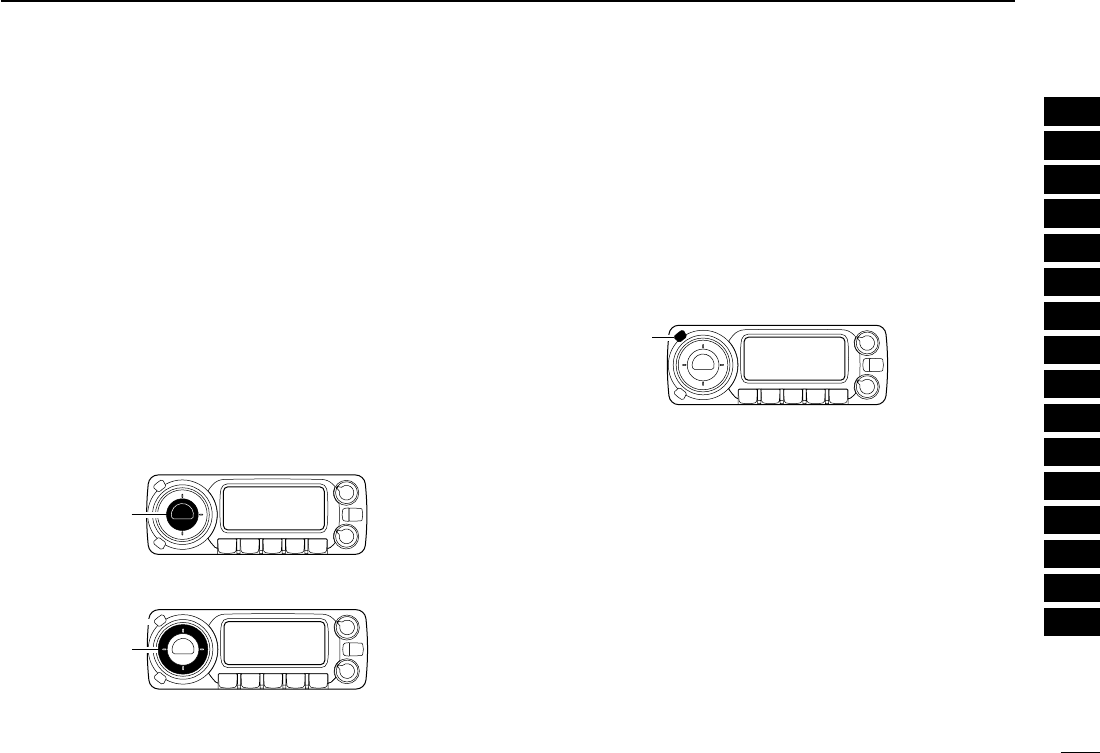
8
2
SETTING A FREQUENCY
New2001
1
2
3
4
5
6
7
8
9
10
11
12
13
14
15
16
■Receive mode selection
Receive modes are determined by the physical properties of
the radio signals. The receiver has 6 receive modes: SSB
LSB, CW, AM, WFM and FM modes. The mode selection is
stored independently in each memory channels.
Typically, AM mode is used for the AM broadcast stations
(0.495–1.620 MHz) and air band (118–135.995 MHz), and
WFM is used for FM broadcast stations (76–107.9 MHz).
When Automatic mode is selected, IF filter passband width,
tuning step, etc., are selected automatically after inputting a
frequency. (p. ??)
➥Push [TS•MODE] for 1 sec. to enter the receive mode se-
lect mode.
rRotate [DIAL] to select the desired mode.
tPush [TS•MODE] to exit the receive mode select mode.
■Lock function
To prevent accidental frequency changes and unnecessary
function access, use the lock function.
➥Push [SET•LOCK] for 1 sec. to turn the lock function ON
and OFF.
•[SET•LOCK] (lock function only), [MONI•T/T•SCAN] (monitor
function only), [PWR], [VOL] and [SQL] can be used while the
channel lock function is in use.
[SET•LOCK]
[DIAL]
[TS•MODE]
! IC-R1500.qxd 05.10.21 10:07 AM Page 8 (1,1)
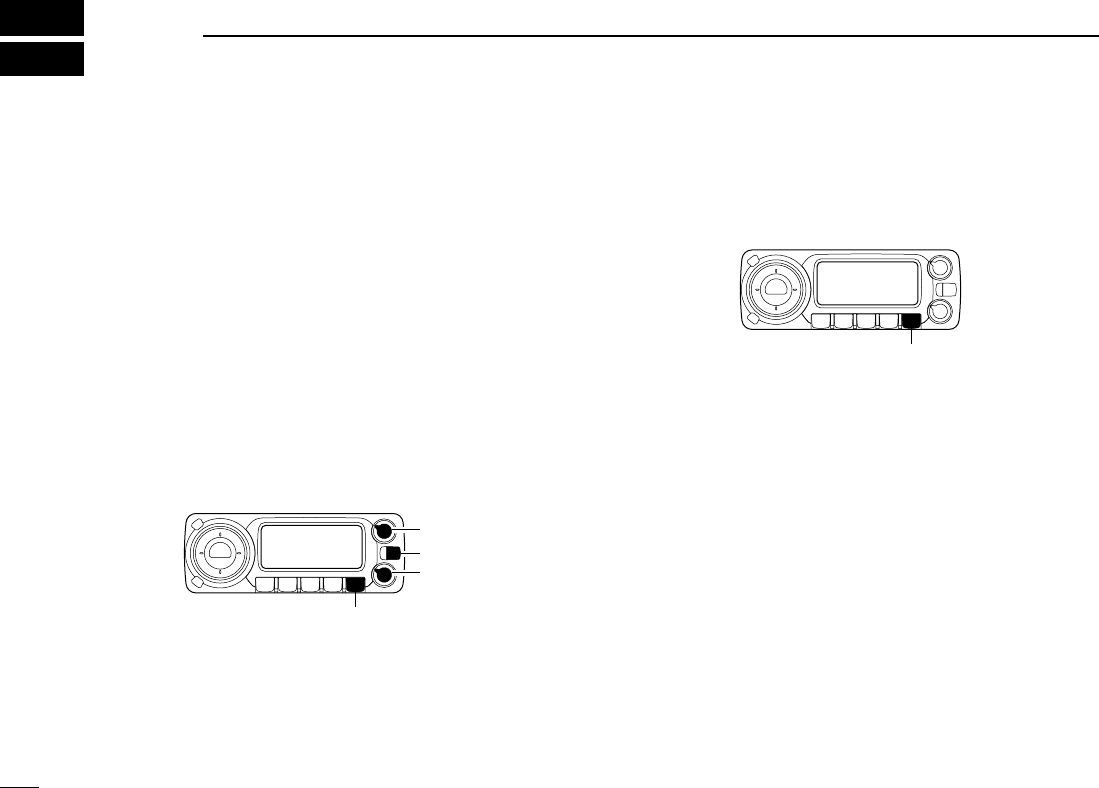
9
BASIC OPERATION
New2001New2001
3
■Receiving
qPush [PWR] for 1 sec. to turn power ON.
wSet the audio level.
➥Push [MONI•T/T-SCAN] to open the squelch.
➥Rotate [VOL] to adjust the audio level.
➥Push [MONI•T/T-SCAN] to close the squelch.
eSet the squelch level.
➥Rotate [SQL] fully counterclockwise in advance, then
rotate [SQL] clockwise until the noise just disappears.
• When interference is received, rotate [SQL] clockwise again
for attenuator operation. (p. ??)
rSet the receive frequency. (pgs. ??, ??)
tWhen receiving a signal on the set frequency, squelch
opens and the receiver emits audio.
• “BUSY” appears and the S-meter indicator shows the relative
signal strength for the received signal.
■Monitor function
This function is used to listen to weak signals without disturb-
ing the squelch setting or to open the squelch manually even
when mute functions such as the tone squelch are in use.
➥Push [MONI•T/T-SCAN] to open the squelch.
• “BUSY” blinks.
• Push [MONI•T/T-SCAN] again to cancel the function.
[MONI•T/T-SCAN]
[PWR]
[VOL]
[SQL]
[MONI•T/T-SCAN]
! IC-R1500.qxd 05.10.21 10:07 AM Page 9 (1,1)
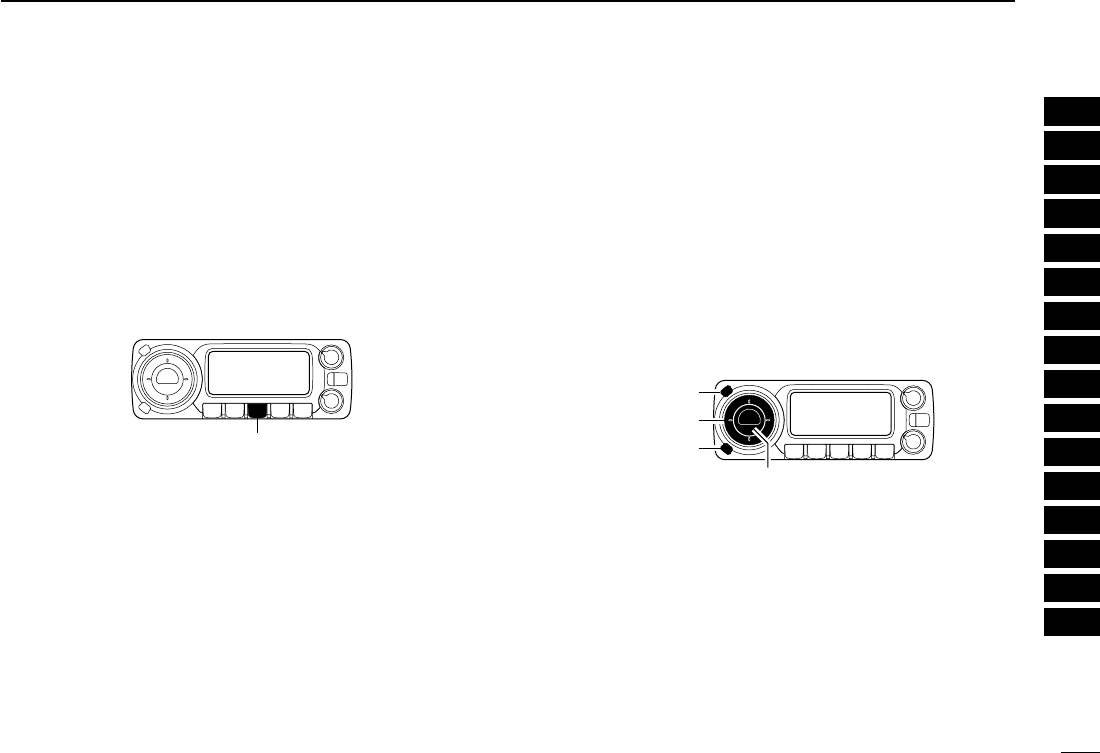
10
3
BASIC OPERATION
1
2
3
4
5
6
7
8
9
10
11
12
13
14
15
16
New2001
■Squelch attenuator
The attenuator prevents a desired signal from distorting when
very strong signals are near the desired frequency or when
very strong electric fields, such as from a broadcasting sta-
tion, are near your location. The attenuator gain is about 20
dB.
➥Push [ATT•PRIO] to toggle the attenuator function ON and
OFF.
• “ATT” appears when the attenuator function is in use.
■AFC function [
The AFC (Automatic Frequency Control) function tunes the
displayed frequency automatically when an off-center fre-
quency is received. It activates in FM/WFM modes only.
qSelect FM mode.
wPush [SET•LOCK] to enter set mode.
ePush [SET•LOCK] or [S.MW•MW] several times until
“AFC” appears.
rRotate [DIAL] to toggle the AFC function ON and OFF.
tPush [TS•MODE] to exit set mode.
• “AFC” appears when the AFC function is in use.
[TS•MODE]
[DIAL]
[S.MW•MW]
[SET•LOCK]
[ATT•PRIO]
! IC-R1500.qxd 05.10.21 10:07 AM Page 10 (1,1)
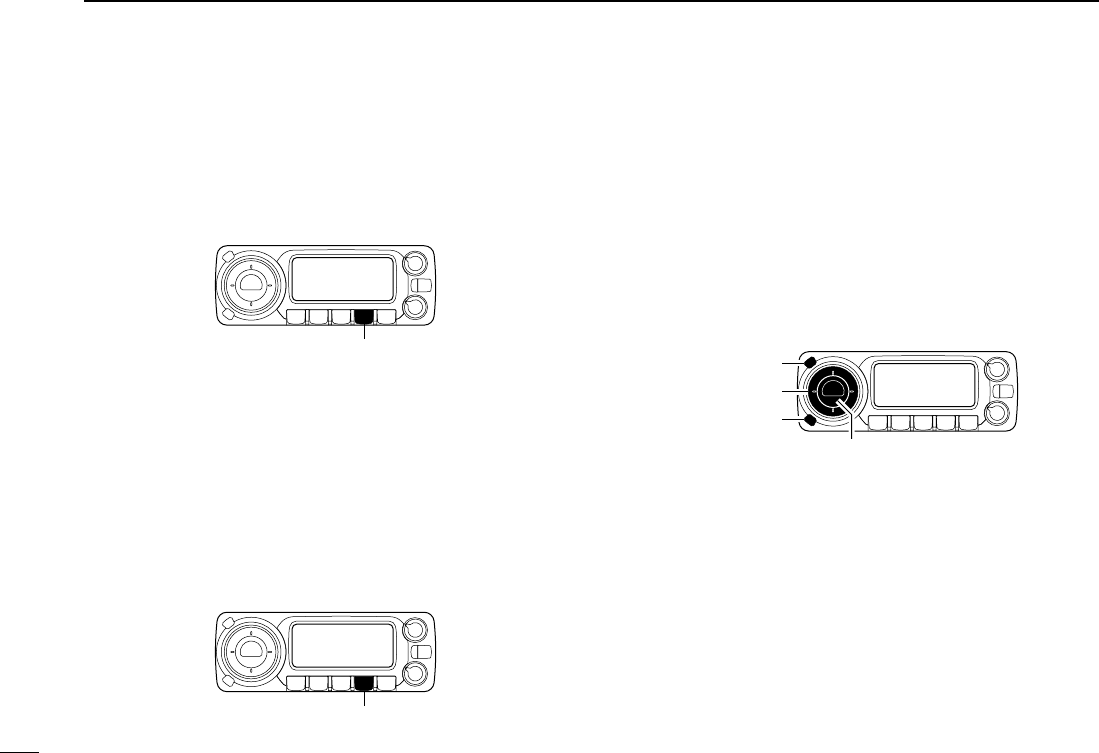
11
3BASIC OPERATION
New2001
■NB function
The NB (noise blanker) function removes pulse-type noise
when USB, LSB or CW mode is selected.
➥Push [NB•AGC] to toggle the NB function ON and OFF.
• “NB” appears when the NB function is in use.
■AGC function
The AGC (Automatic Gain Control) function controls receiver
gain to produce a constant audio output level even when the
received signal strength is varied by fading, etc.
➥Push [NB•AGC] for 1 sec. to toggle the AGC function ON
and OFF.
• “AGC” appears when the AGC function is in use.
■VSC function [
The VSC (Voice Squelch Control) function opens the squelch
only when receiving a modulated signal. This function is very
useful while scanning, the VSC pauses only when modulated
signals are received. Scanning continues when unmodulated
or beat signals are received.
qPush [SET•LOCK] to enter set mode.
wPush [SET•LOCK] or [S.MW•MW] several times until
“VSC” appears.
eRotate [DIAL] to toggle the VSC function ON and OFF.
rPush [TS•MODE] to exit set mode.
• “VSC” appears when the VSC function is in use.
[TS•MODE]
[DIAL]
[S.MW•MW]
[SET•LOCK]
[NB•AGC]
[NB•AGC]
! IC-R1500.qxd 05.10.21 10:07 AM Page 11 (1,1)
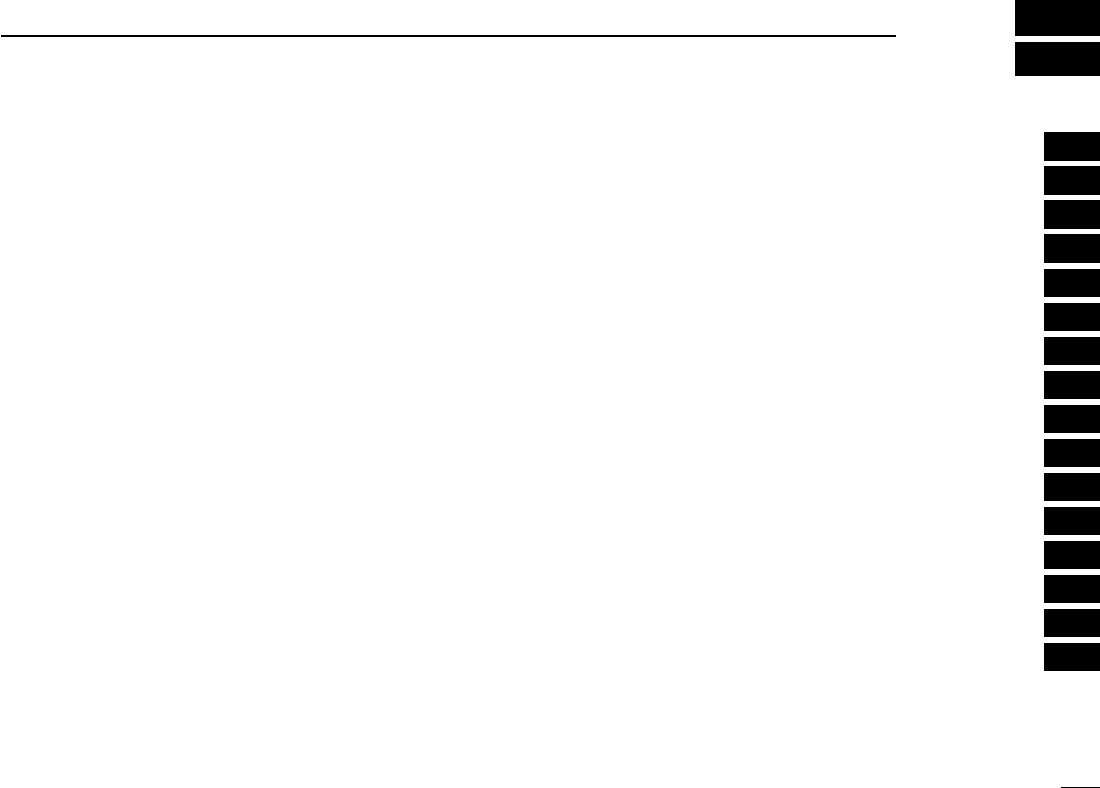
12
4
MEMORY OPERATION
1
2
3
4
5
6
7
8
9
10
11
12
13
14
15
16
■General description
The receiver has 1050 memory channels including 50 scan
edge memory channels (25 pairs) for storage of often-used
frequencies. And a total of 26 memory banks, A to Z are avail-
able for usage by group, etc. Up to 100 channels can be as-
signed into a bank.
DDMemory channel contents
The following information can be programmed into memory
channels:
• Operating frequency (p. ??)
• Receive mode (p. ??)
• Tone squelch or DTCS squelch ON/OFF (p. ??)
• Tone squelch frequency or DTCS code with polarity
(p. ??)
• Scan skip information (p. ??)
■Memory channel selection
qPush [MR•SKIP] several times to select memory mode.
•“!” indicator appears.
wRotate [DIAL] to select the desired memory channel.
• Programmed memory channels only can be selected.
! IC-R1500.qxd 05.10.21 10:07 AM Page 12 (1,1)

13
4MEMORY OPERATION
New2001
VFO settings, including the set mode contents such as sub-
audible tone frequency or scan skip information, can be pro-
grammed into a memory channel.
qPush [V/MHz•SCAN] to select VFO mode.
wSet the desired frequency using [DIAL].
➥Set other data (e.g. subaudible tone frequency, scan
skip information, etc.) if required.
ePush [S.MW•MW] to select the select memory write con-
dition.
•“!” indicator and the memory channel number blink.
rRotate [DIAL] to select the desired memory channel to be
programmed.
• Memory channels not yet programmed are blank.
tPush [S.MW•MW] for 1 sec. to program.
• 3 beeps sound
• Memory channel number automatically increases when contin-
uing to push [S.MW•MW] after programming.
✔CONVENIENT
Memory programming can be performed in versatile ways
e.g. memory channel to the same (or different) memory chan-
nel, etc.
■Programming a memory channel
! IC-R1500.qxd 05.10.21 10:07 AM Page 13 (1,1)
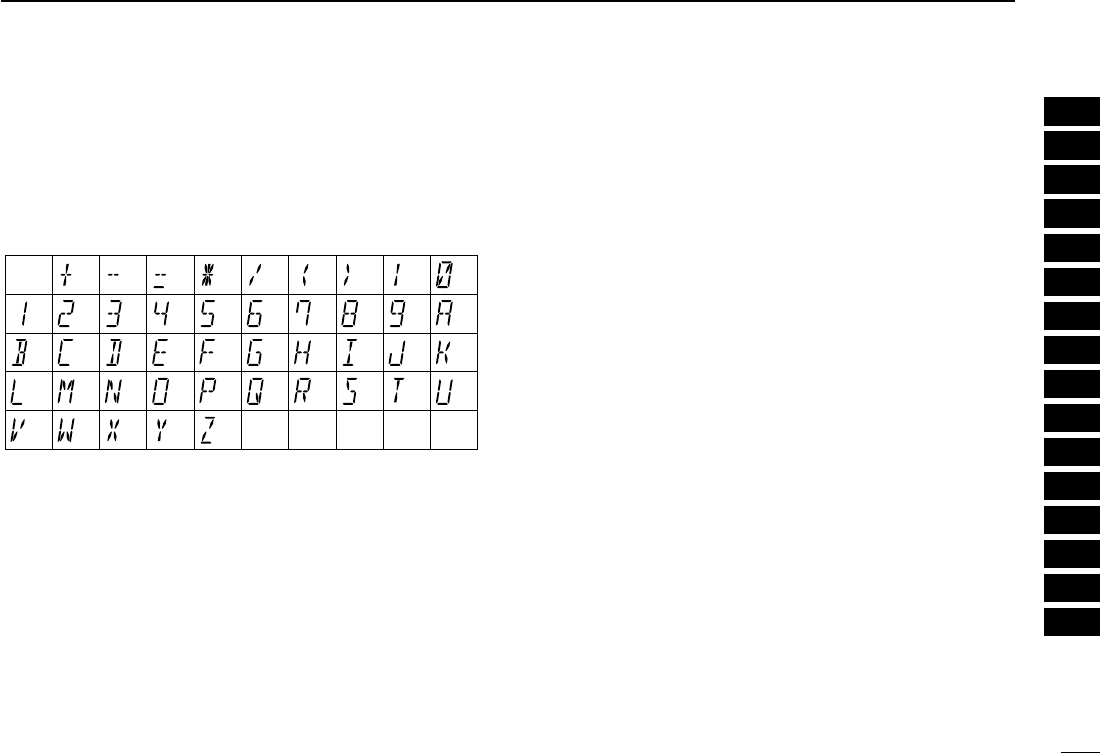
14
4
MEMORY OPERATION
New2001
1
2
3
4
5
6
7
8
9
10
11
12
13
14
15
16
■Programming channel names
Each memory channel can be programmed with an alphanu-
meric channel name for easy recognition and can be indi-
cated independently by channel. Names can be a maximum
of 8 characters— see the table below for available charac-
ters.
qSelect the desired memory channel.
➥Push [MR•SKIP] several times to select memory mode,
then rotate [DIAL] to select the desired memory channel.
•“!” and memory channel number blink.
ePush [S.MW•MW] to select the memory name program-
ming condition.
• Frequency readouts disappear and a cursor blinks.
rRotate [DIAL] to select the desired character.
• The selected character blinks.
tPush [SET•LOCK] to move the cursor to the right.
yRepeat steps rand tuntil the desired channel names
are displayed.
uPush [S.MW•MW] for 1 sec. to program the name and exit
the channel name programming condition.
(1)
(B)
(L)
(V)
(+)
(2)
(C)
(
M
)
(
W
)
(–)
(3)
(
D
)
(N)
(X)
(=)
(4)
(E)
(O)
(Y)
(✱)
(5)
(F)
(P)
(Z)
(/)
(6)
(G)
(
Q
)
(space)
(7)
(()
(
H
)
(
R
)
())
(8)
(I)
(S)
(|)
(9)
(J)
(T)
(0)
(A)
(
K
)
(U)
! IC-R1500.qxd 05.10.21 10:07 AM Page 14 (1,1)

15
4MEMORY OPERATION
New2001
DDTo indicate the channel name [
The channel name indication can be set for independent
memory channels.
qSelect the desired memory channel.
➥Push [MR•SKIP] several times to select memory mode,
then rotate [DIAL] to select the desired memory channel.
•“!” and memory channel number blink.
ePush [SET•LOCK] to enter set mode.
rPush [SET•LOCK] or [S.MW•MW] several times to select
“ANM” item.
tRotate [DIAL] to turn the memory name indication ON.
yPush [TS•MODE] to exit set mode.
NOTE: When no memory name is programmed, the stored
frequency is displayed.
! IC-R1500.qxd 05.10.21 10:07 AM Page 15 (1,1)

16
4
MEMORY OPERATION
New2001
1
2
3
4
5
6
7
8
9
10
11
12
13
14
15
16
■Copying memory contents
This function transfers a memory channel’s contents to VFO
(or another memory channel). This is useful when searching
for signals around a memory channel frequency and for re-
calling the subaudible tone frequency etc.
DMemory➪VFO
qSelect the desired memory channel to be copied.
➥Push [MR•SKIP] several times to select memory mode,
then rotate [DIAL] to select the desired memory chan-
nel.
•“!” and memory channel number blink.
wPush [S.MW•MW] for 1 sec. to transfer the selected mem-
ory channel contents to the VFO.
• VFO mode is selected automatically.
DMemory➪memory
qSelect the desired memory channel to be transferred.
➥Push [MR•SKIP] several times to select memory mode,
then rotate [DIAL] to select the desired memory channel.
•“!” and memory channel number blink.
wPush [S.MW•MW] momentarily.
•“!” indicator and “-- -- --” indication blink, and shows VFO con-
ditions.
eRotate [DIAL] to select the target memory channel.
• Scan edge channels, 1A/1B to 50A/50B can also be selected.
rPush [S.MW•MW] for 1 sec. to transfer the selected mem-
ory channel contents to the target memory.
• The targeted memory and transferred contents are indicated.
! IC-R1500.qxd 05.10.21 10:07 AM Page 16 (1,1)

17
4MEMORY OPERATION
New2001
■Memory clearing
Contents of programmed memories can be cleared (blanked),
if desired.
qPush [V/MHz•SCAN] to select VFO mode.
wPush [S.MW•MW] to select the select memory write con-
dition.
•“!” and the memory channel number blink.
eRotate [DIAL] to select the memory channel to be cleared.
• Memory channels not yet programmed are blank.
rPush [S.MW•MW] momentarily, then push [S.MW•MW]
again for 1 sec.
☞This operation must be performed within 1.5 sec.
• 3 beeps sound.
• The cleared channel changes to blank channel
•“!” and the memory channel number blink continuously.
tPush [V/MHz•SCAN] to return to VFO mode.
☞NOTE: Be careful!— the contents of cleared memories
CANNOT be recalled.
! IC-R1500.qxd 05.10.21 10:07 AM Page 17 (1,1)

18
4
MEMORY OPERATION
New2001
1
2
3
4
5
6
7
8
9
10
11
12
13
14
15
16
■Memory bank selection
The IC-R1500 has a total of 26 banks (A to Z). Regular mem-
ory channels, 1 to 1000, are assigned into the desired bank
for easy memory management.
qPush [MR•SKIP] several times to select memory mode, if
desired.
wPush [TS•MODE] to select memory bank condition.
• Bank’s initial blinks
eRotate [DIAL] to select the desired bank, A to P.
• Banks that have no programmed contents are skipped.
rPush [TS•MODE] to set the bank.
• Bank’s initial stops blinking.
tRotate [DIAL] to select the contents in the bank.
• No channel numbers are displayed for memory bank operation.
yTo return to regular memory condition, push [MR•SKIP]
twice.
■Memory bank setting
[
qSelect the desired memory channel.
➥Push [MR•SKIP] several times to select memory mode,
then rotate [DIAL] to select the desired memory chan-
nel.
•“!” and memory channel number blink.
wPush [SET•LOCK] to enter set mode.
ePush [SET•LOCK] or [S.MW•MW] several times until
“bAk” appears.
rRotate [DIAL] to select the desired bank, A to Z.
• Banks that have no programmed contents are skipped.
tPush [TS•MODE] to exit set mode.
! IC-R1500.qxd 05.10.21 10:07 AM Page 18 (1,1)

19
4MEMORY OPERATION
New2001
■Transferring bank contents
[
The bank contents of programmed memory channels can be
cleared or transferred to another bank.
INFORMATION: Even if the memory bank contents are
cleared, the memory channel contents still remain pro-
grammed.
qSelect the desired bank contents to be transferred or
erased from the bank.
➥Push [MR•SKIP] several times to select memory mode
➥Push [TS•MODE] then rotate [DIAL] to select the de-
sired memory bank.
• Bank’s initial blinks.
➥Push [TS•MODE] to select the bank then rotate [DIAL]
to select the desired contents.
• Bank’s initial stops blinking.
wPush [SET•LOCK] to enter set mode.
ePush [SET•LOCK] or [S.MW•MW] several times until
“bAk” appears.
• The bank’s initial for the selected memory channel is displayed.
rRotate [DIAL] to select the desired bank initial to transfer
or erase.
• Select “-- --” indication when erasing the contents from the bank.
tPush [TS•MODE] to set the bank and exit set mode.
yRepeat steps qto rfor transferring or erasing an another
banks contents.
! IC-R1500.qxd 05.10.21 10:07 AM Page 19 (1,1)
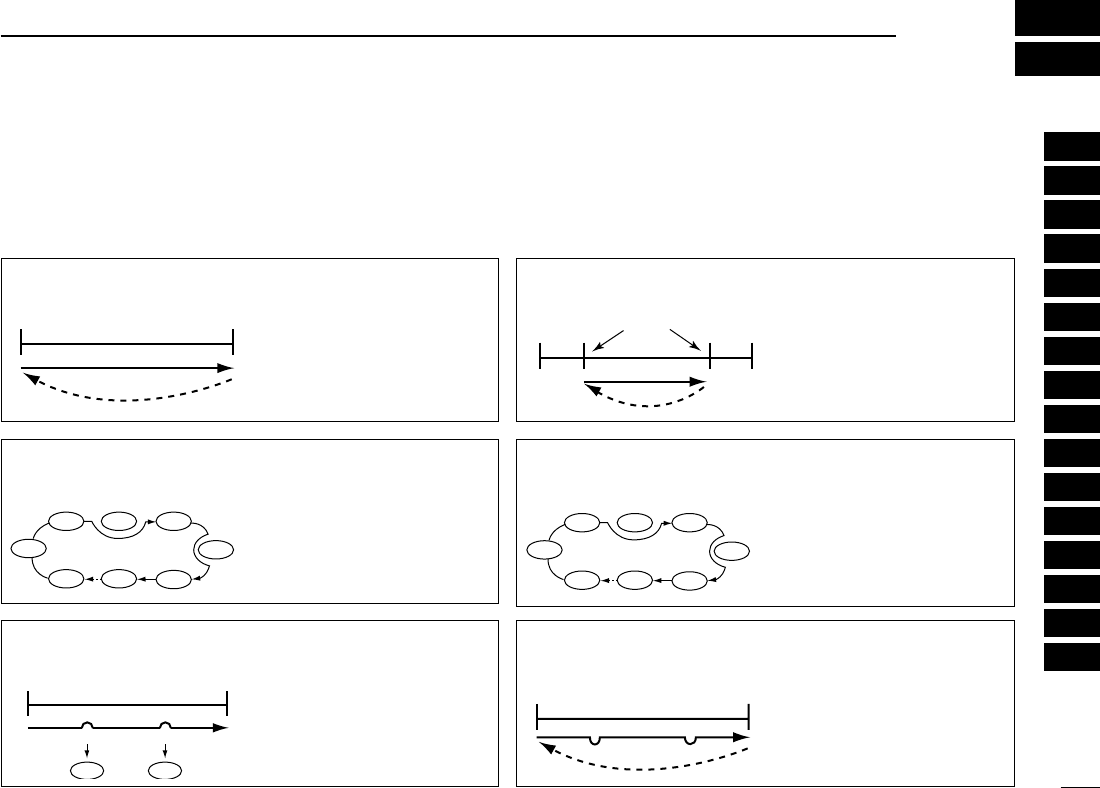
20
5
SCAN OPERATION
1
2
3
4
5
6
7
8
9
10
11
12
13
14
15
16
■Scan types
Scanning searches for signals automatically and makes it
easier to locate new stations for contact or listening purposes.
There are 3 scan types and 4 resume conditions to suit your
operating needs.
FULL SCAN (p. ??) Repeatedly scans all frequen-
cies over the entire band.
Some frequency ranges are
not scanned according to the
frequency coverage of the re-
ceiver’s version.
150
kHz
3304.999
MHz
Scan
Jump
ALL/SELECTED BANK
SCAN (p. ??)
Repeatedly scans all bank
channels or selected bank
channels. The skip scan is
also available.
SKIP
SKIP
A99 A03
A00 A01 A02
A04
A98
A05
FREQUENCY/MEMORY
SKIP FUNCTION (p. ??)
Skips unwanted frequencies
or channels that inconve-
niently stop scanning. This
function can be turned ON
and OFF by pushing and
holding [MR•SKIP] in either
VFO or memory mode.
Band
edge
Band
edge
Scan
SKIP SKIP
Jump
PROGRAMMED SCAN
(p. ??)
Repeatedly scans between
two user-programmed fre-
quencies. Used for checking
for frequencies within a speci-
fied range such as repeater
output frequencies, etc.
Band
edge xxA xxB
Band
edge
Scan edges
Scan
Jump
MEMORY (SKIP) SCAN
(p. ??)
Repeatedly scans memory
channels except those set as
skip channel. Skip channels
can be turned ON and OFF
by pushing and holding
[MR•SKIP] in memory mode.
SKIP
SKIP
M 0 M 4
M 1 M 2 M 3
M 5
M 199
M 6
AUTO MEMORY WRITE
SCAN (p. ??)
The frequencies that the pro-
grammed scan stops are au-
tomatically programmed into a
selected memory bank.
Scan edge Scan edge
ch 1 ch 2
Pause
Program Program
Pause
Scan
! IC-R1500.qxd 05.10.21 10:07 AM Page 20 (1,1)
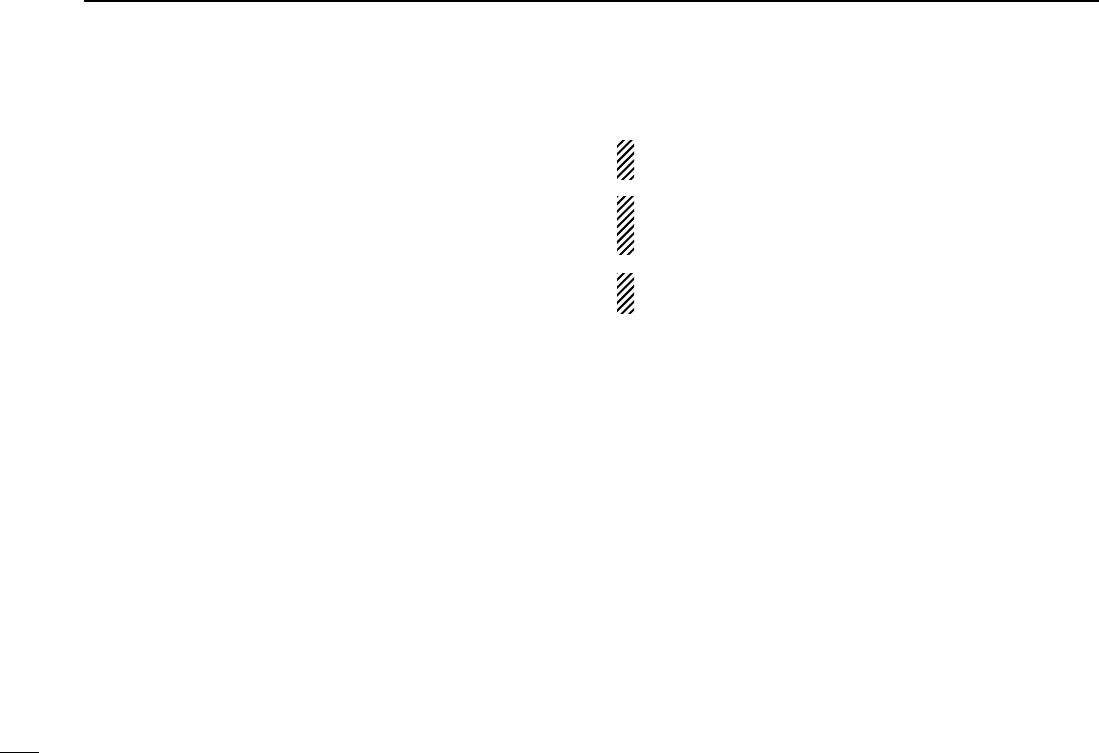
21
5SCAN OPERATION
New2001
■Scan start/stop
DPreparation
Scan resume condition (p. ??); program the scan edges
(p. ??); program 2 or more memory channels (p. ??); set skip
settings (p. ??), if desired.
DOperation
qPush [V/MHz•SCAN] to select VFO mode for full/pro-
grammed scan; or push [MR•SKIP] to select memory
mode for memory/bank scan.
• Select the desired bank with [TS•MODE] for bank scan.
wSet the squelch level to the point where noise is just
muted.
ePush [V/MHz•SCAN] for 1 sec. to start the scan.
• To change the scanning direction, rotate [DIAL].
• The memory channel readout blinks the scan type as follows:
rPush [TS•MODE] to switch full and programmed scan
(P00 to P24), if VFO is selected in step q.
tTo stop the scan, push [V/MHz•SCAN].
About the scanning steps: The selected tuning step in
each frequency band (in VFO mode) is used during scan
IMPORTANT!: To perform memory or bank scan, 2 or
more memory/bank channels MUST be programmed, oth-
erwise the scan will not start.
The bank-link setting can be changed in expanded set
mode. See page ?? for details.
! IC-R1500.qxd 05.10.21 10:07 AM Page 21 (1,1)

22
5
SCAN OPERATION
New2001
1
2
3
4
5
6
7
8
9
10
11
12
13
14
15
16
■Scan edges programming
Scan edges can be programmed in the same manner as
memory channels. Scan edges are programmed into scan
edges, 00A/00B to 24A/24B, in memory channels.
qPush [V/MHz•SCAN] to select VFO mode.
wSet the edge frequency of the desired frequency range:
➥Set the frequency using [DIAL].
➥Set other data (e.g. tone squelch, etc.), if desired.
ePush [S.MW•MW].
•“!” indicator and channel number blink.
rRotate [DIAL] to select one of scan edge channel, 00A to
24A.
tPush [S.MW•MW] for 1 sec. to program.
• 3 beeps sound and VFO is automatically selected.
• Scan edge 00B to 24B is automatically selected when continuing
to push [S.MW•MW] after programming.
yTo program a frequency for the other pair of scan edges,
00B to 24B, repeat steps qto r.
• If the same frequency is programmed into a pair of scan edges,
programmed scan will not function.
! IC-R1500.qxd 05.10.21 10:07 AM Page 22 (1,1)
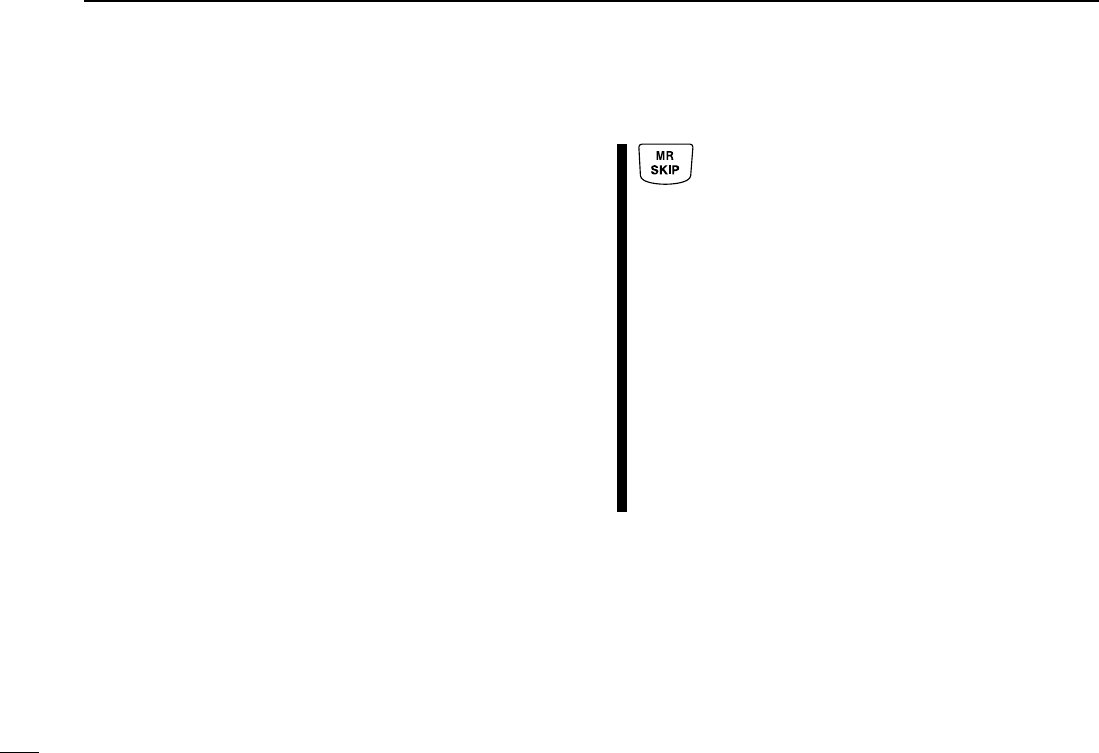
23
5SCAN OPERATION
New2001
You can set the selected memory channel as a skip channel
which is skipped during memory skip scan. In addition, it can
be set as a skip channel for both memory skip scan and
frequency skip scan. These are useful to speed up the scan
interval.
qSelect a memory channel.
➥Push [MR•SKIP] several times to select memory mode,
then rotate [DIAL] to select the desired memory channel
to be a skip channel.
•“!” and memory channel number blink.
wPush [SET•LOCK] to enter set mode.
ePush [SET•LOCK] or [S.MW•MW] several times until
“CHS” appears.
rRotate [DIAL] to select the skip condition for the selected
channel.
• CHS-ON : When “~” appears, the channel is skipped during
scan.
When “P ~” appears, the channel is skipped during
scan and the programmed frequency is skipped dur-
ing VFO scan, such as programmed scan.
• CHS-OF : The channel is scanned during scan. (“~” disap-
pears)
tPush [TS•MODE] to exit set mode.
zSelect a memory channel.
➥Push [MR•SKIP] several times to select
memory mode, then rotate [DIAL] to select
the desired memory channel to be a skip
channel.
•“!” and memory channel number blink.
xPush [MR•SKIP] for 1 sec. to set the selected
channel as a skip channel.
• When “~” appears : The channel is skipped
during scan.
• When “P ~” appears : The channel is skipped
during scan and the pro-
grammed frequency is
skipped during VFO scan,
such as programmed
scan.
• When “~” disappears: The channel is scanned
during scan.
■Skip channel/frequency setting [
! IC-R1500.qxd 05.10.21 10:07 AM Page 23 (1,1)
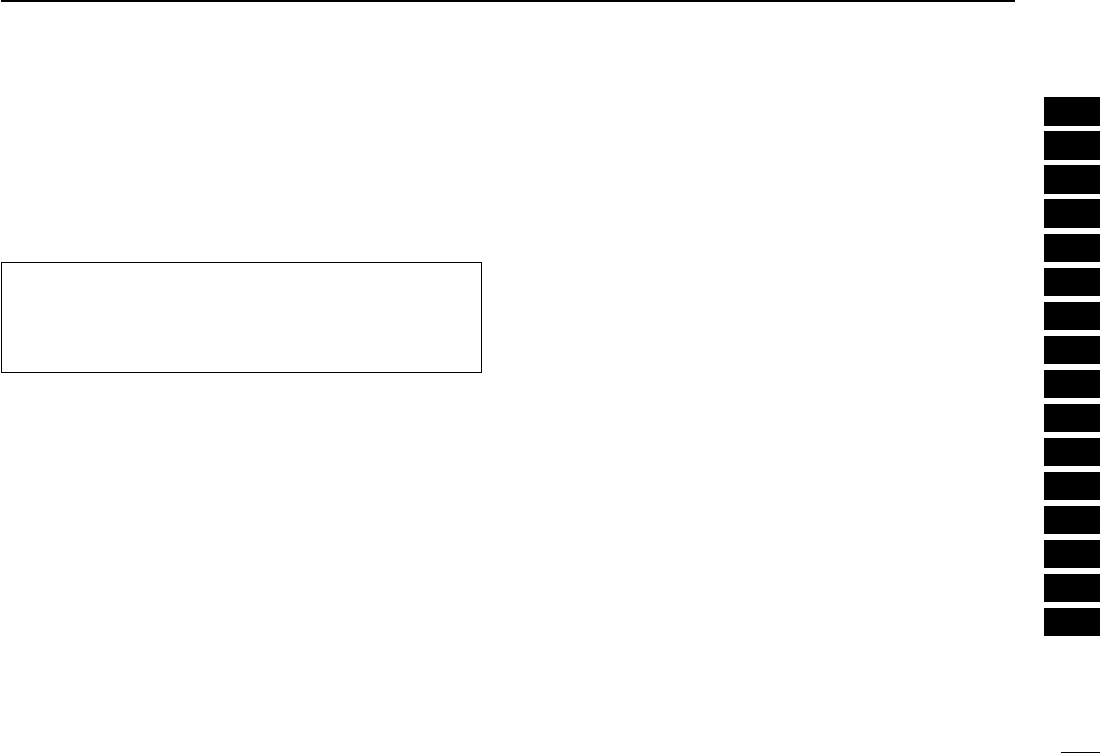
24
5
SCAN OPERATION
New2001
1
2
3
4
5
6
7
8
9
10
11
12
13
14
15
16
■Scan resume condition
[
The scan resume condition can be selected as timer or pause
scan. The selected resume condition is also used for priority
watch. (p. ??)
qPush [SET•LOCK] to enter set mode.
wPush [SET•LOCK] or [S.MW•MW] several times until
“SCT” or “SCP” appears as shown above.
• When “d” is displayed in place of the 100 MHz digit, cancel the
DTMF memory encoder in advance. (p. ??)
eRotate [DIAL] to set the desired timer:
• “SCP-2” : Scan pauses until the signal disappears and then re-
sumes 2 sec. later.
• “SCT-15” : Scan pauses 15 sec. while receiving a signal.
• “SCT-10” : Scan pauses 10 sec. while receiving a signal.
• “SCT-5” : Scan pauses 5 sec. while receiving a signal.
rPush [TS•MODE] to exit set mode.
! IC-R1500.qxd 05.10.21 10:07 AM Page 24 (1,1)
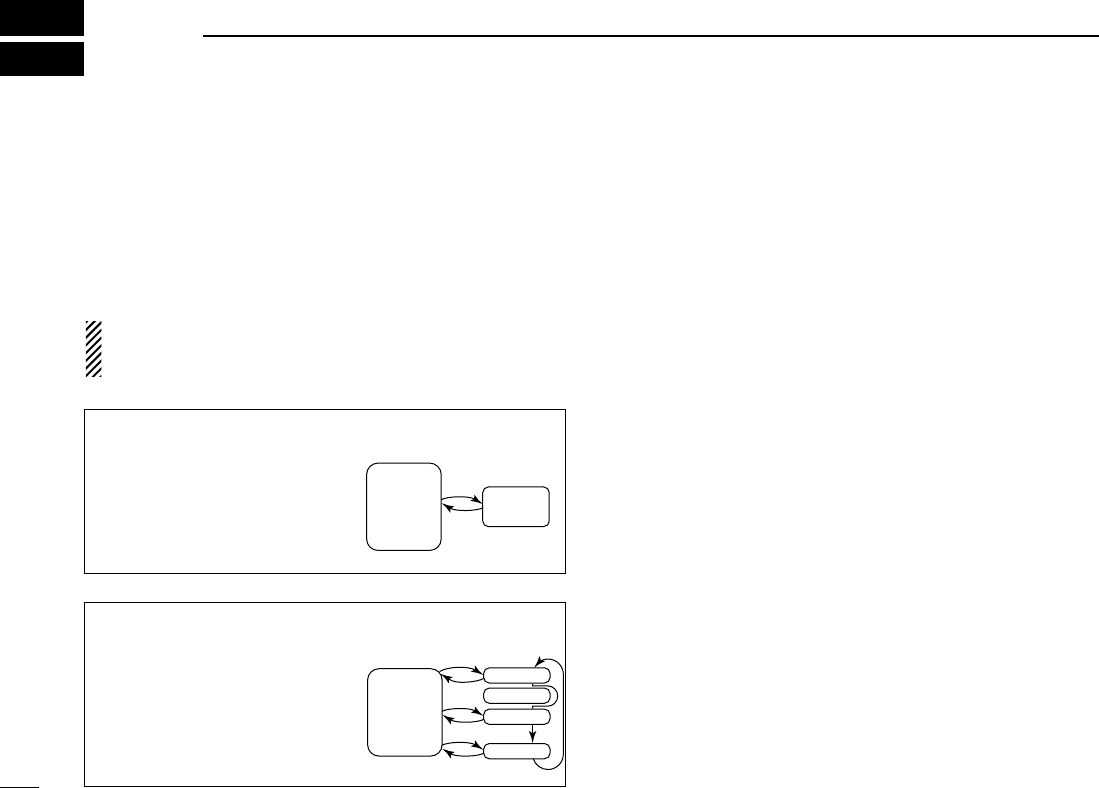
25
PRIORITY WATCH
New2001New2001
6
■Priority watch types
Priority watch checks for signals on the frequency every
5 sec. while operating on a VFO frequency or scanning. The
receiver has 3 priority watch types to suit your needs.
The watch resumes according to the selected scan resume
condition. See p. ?? for details.
NOTE: If the pocket beep function is activated, the receiver
automatically selects the tone squelch function when pri-
ority watch starts.
■Priority watch operation
qSelect VFO mode; then, set an operating frequency.
wSet the watching channel(s).
For memory channel watch:
Select the desired memory channel.
For memory scan watch:
Select memory mode, or the desired bank group; then,
push [V/MHz•SCAN] for 1 sec. to start memory scan.
ePush [ATT•PRIO] for 1 sec. to start the watch.
• “PRIO” indicator appears.
• The receiver checks the memory/bank channel(s) every 5 sec.
• The watch resumes according to the selected scan resume con-
dition. (p. ??)
• While the watch is pausing, pushing [ATT•PRIO] resumes the
watch manually.
rPush [ATT•PRIO] for 1 sec. to stop the watch.
MEMORY CHANNEL WATCH
While operating on a VFO fre-
quency, priority watch checks for
a signal on the selected memory
channel every 5 sec.
• A memory channel with skip infor-
mation can be watched.
5 sec.
VFO
frequency
Memory
channel
MEMORY SCAN WATCH
While operating on a VFO fre-
quency, priority watch checks for
signals on each memory chan-
nel in sequence.
• The memory skip function and/or
memory bank scan is useful to
speed up the scan.
5 sec.
VFO
frequency
SKIP
Mch 000
Mch 001
Mch 001
Mch 999
! IC-R1500.qxd 05.10.21 10:07 AM Page 25 (1,1)
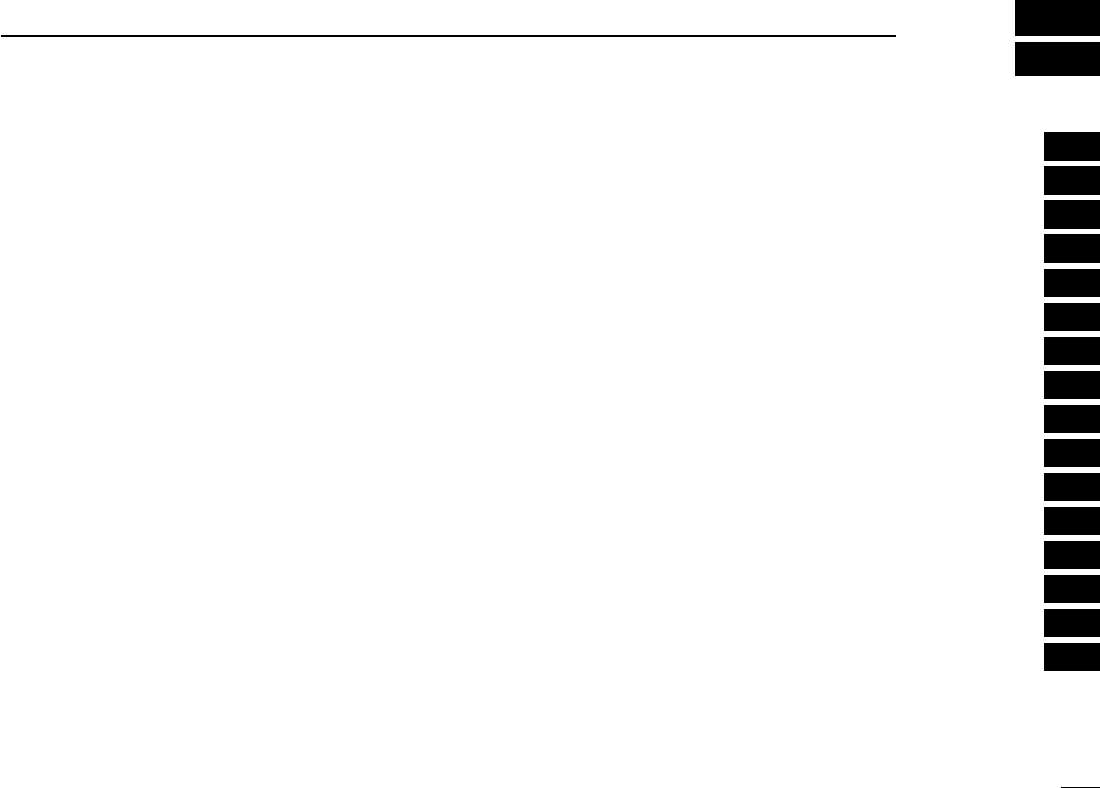
26
7
POCKET BEEP AND TONE SQUELCH
1
2
3
4
5
6
7
8
9
10
11
12
13
14
15
16
New2001
■Pocket beep operation
This function uses subaudible tones for calling and can be
used as a “common pager” to inform you that someone has
called while you were away from the receiver.
DWaiting for a call from a specific station
qSet the operating frequency in FM mode.
wPush [SET•LOCK] to enter set mode.
ePush [SET•LOCK] or [S.MW•MW] several times until “Ct”
(when selecting the tone squelch frequency) or “Dt” (when
selecting the DTCS code squelch) appears.
rRotate [DIAL] to select the desired tone frequency or
DTCS code.
tWhen operating the pocket beep function with DTCS code
squelch, push [SET•LOCK] once then rotate [DIAL] to se-
lect the DTCS polarity.
yPush [TS•MODE] to exit set mode.
uPush [MONI•T/T-SCAN] for 1 sec and rotate [DIAL] until
“S” or “ S” appears to turn the pocket beep
function ON with tone/DTCS squelch, respectively.
iWhen a signal with the matched tone is received, the re-
ceiver emits beep tones and blinks “S.”
• Beep tones sound for 30 sec. and “S” blinks. To stop the
beeps and blinking manually, push any key. When the beep
tones are not stopped manually, “S” continues blinking until
[TONE•T-SCAN] is pushed (see step o).
oPush [TONE•T-SCAN] several times until “T SQL” or
“DTCS” disappears to cancel the tone squelch or DTCS
squelch function.
! IC-R1500.qxd 05.10.21 10:07 AM Page 26 (1,1)
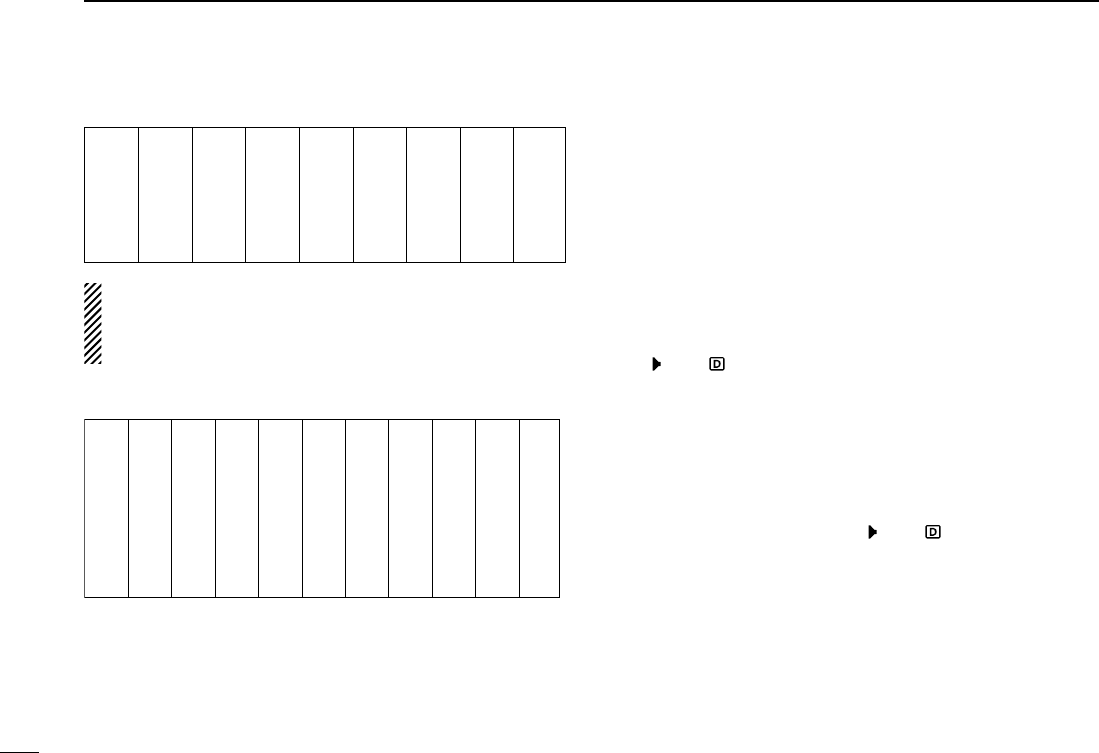
27
7POCKET BEEP AND TONE SQUELCH
New2001
DAvailable tone frequency list
NOTE: The receiver has 51 tone frequencies and conse-
quently their spacing is narrow compared to units having
38 tones. Therefore, some tone frequencies may receive
interference from adjacent tone frequencies.
DAvailable DTCS code list
DCalling a waiting station using pocket beep
A subaudible tone matched with the station’s CTCSS tone fre-
quency or 3-digit DTCS code with polarity is necessary. Use
the tone squelch on the next page or a subaudible tone en-
coder (pgs. ??, ??).
■Tone/DTCS squelch operation
The tone or DTCS squelch opens only when receiving a sig-
nal with the same pre-programmed subaudible tone or DTCS
code, respectively. You can silently wait for the specified sig-
nal using the same tone.
qSet the operating frequency in FM mode.
wProgram the CTCSS tone frequency or DTCS code in set
mode.
• See steps wto yon p. ?? for programming details.
ePush [MONI•T/T-SCAN] for 1 sec and rotate [DIAL] until
“ ” or “ ” appears in the function display.
rWhen a signal with the matched tone is received, the
squelch opens and the receiver emits audio.
• When the received signal includes an unmatched tone, the
squelch does not open. However, the S-meter indicator shows
the received signal strength.
• To open the squelch manually, push [MONI•T/T-SCAN].
tTo cancel the tone squelch, push [MONI•T/T-SCAN] for 1
sec and rotate [DIAL] until “ ” or “ ” disappears.
023
025
026
031
032
036
043
047
051
053
125
131
132
134
143
145
152
155
156
162
245
246
251
252
255
261
263
265
266
271
356
364
365
371
411
412
413
423
431
432
506
516
523
526
532
546
565
606
612
624
054
065
071
072
073
074
114
115
116
122
165
172
174
205
212
223
225
226
243
244
274
306
311
315
325
331
332
343
346
351
445
446
452
454
455
462
464
465
466
503
627
631
632
654
662
664
703
712
723
731
732
734
743
754
67.0
69.3
71.0
71.9
74.4
77.0
79.7
82.5
85.4
88.5
91.5
94.8
097.4
100.0
103.5
107.2
110.9
114.8
118.8
123.0
127.3
131.8
136.5
141.3
146.2
151.4
156.7
159.8
162.2
165.5
167.9
171.3
173.8
177.3
179.9
183.5
186.2
189.9
192.8
196.6
199.5
203.5
206.5
210.7
218.1
225.7
229.1
233.6
241.8
250.3
254.1
! IC-R1500.qxd 05.10.21 10:07 AM Page 27 (1,1)
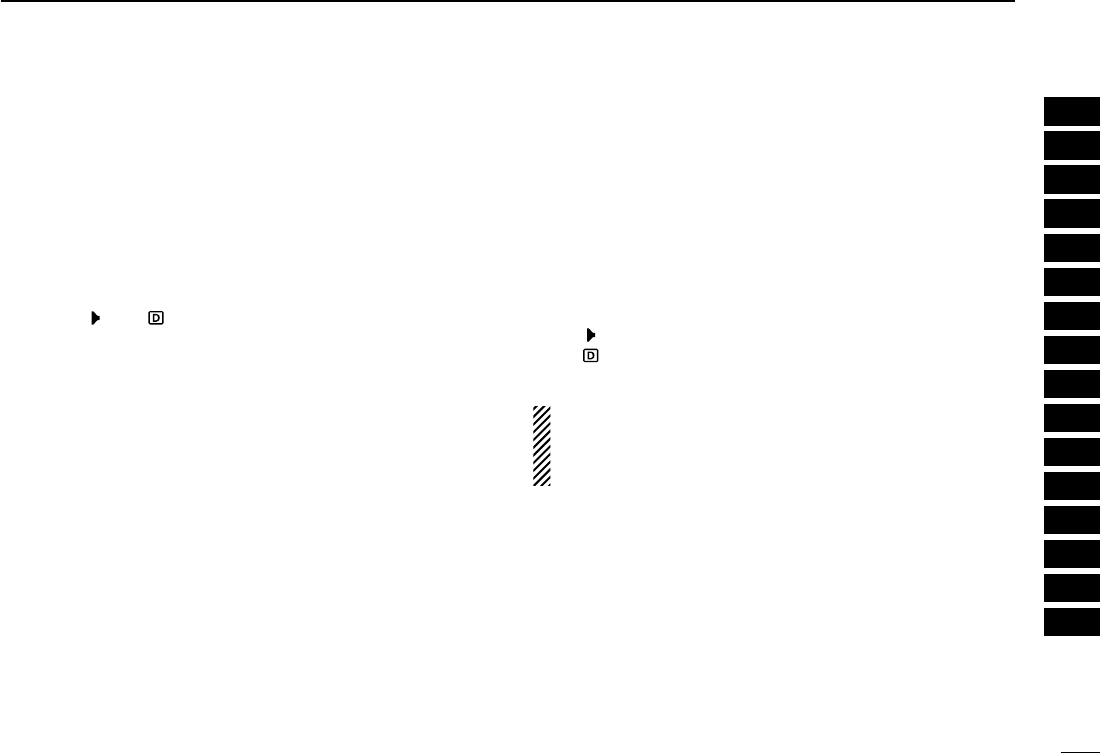
28
7
POCKET BEEP AND TONE SQUELCH
New2001
1
2
3
4
5
6
7
8
9
10
11
12
13
14
15
16
■Tone scan
By monitoring a signal that is being operated with pocket
beep, tone or DTCS squelch function, you can determine the
tone frequency or DTCS code necessary to open a squelch.
qSet the desired operating frequency or memory channel to
be checked for a tone frequency or code.
wPush [MONI•T/T-SCAN] for 1 sec and rotate [DIAL] select
the tone type, tone squelch or DTCS, to be scanned.
• Either “ ” or “ ” appears
ePush [MONI•T/T-SCAN] for 1 sec. to start the tone scan.
• To change the scanning direction, rotate [DIAL].
rWhen the CTCSS tone frequency or 3-digit DTCS code is
matched, the squelch opens and the tone frequency is
temporarily programmed into the selected condition such
as memory channel.
• The tone scan pauses when a CTCSS tone frequency or 3-digit
DTCS code is detected.
• The decoded CTCSS tone frequency or 3-digit DTCS code is
used for the tone encoder or tone encoder/decoder depending
on the selected tone condition or type in step w.
-“”: CTCSS tone encoder/decoder
- “ ” : DTCS tone encoder/decoder
tPush [MONI•T/T-SCAN] to stop the scan.
NOTE: The decoded tone frequency is programmed tem-
porarily when a memory or call channel is selected. How-
ever, this will be cleared when the memory/call channel is
re-selected.
! IC-R1500.qxd 05.10.21 10:07 AM Page 28 (1,1)
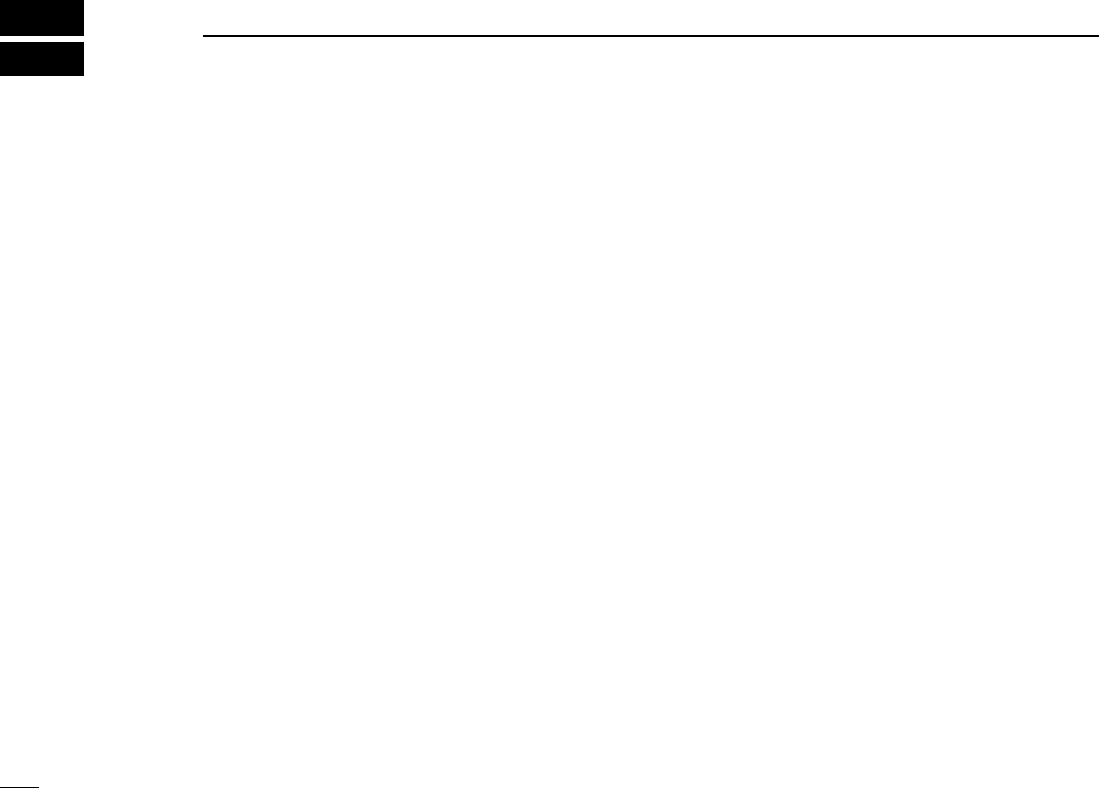
29
SET MODE
New2001New2001
8
■General
DDSet mode operation
qPush [SET•LOCK] to enter the set mode.
wPush [SET•LOCK] or [S.MW•MW] to select the desired
item.
■Set mode items
eRotate [DIAL] to select the desired condition of the item.
rPush [TS•MODE] to exit set mode.
! IC-R1500.qxd 05.10.21 10:07 AM Page 29 (1,1)
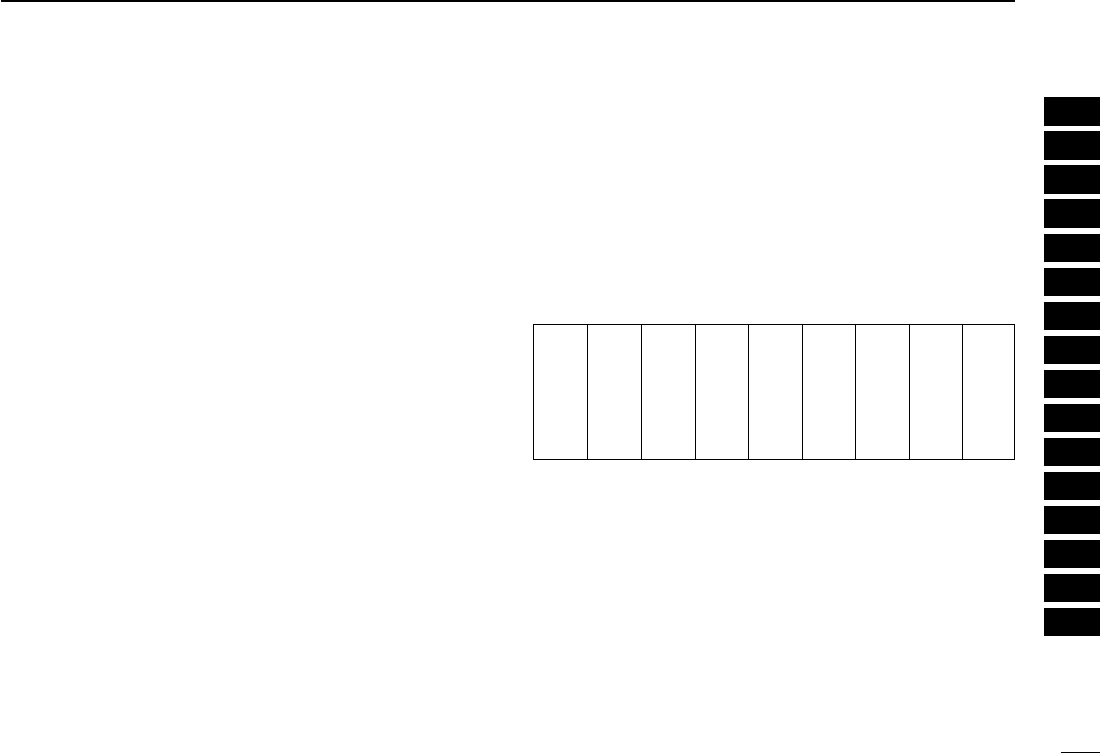
30
8
SET MODE
1
2
3
4
5
6
7
8
9
10
11
12
13
14
15
16
New2001
DDDisplay dimmer
Adjust the display lighting condition.
The levels 1 (dark) to 8 (bright: default) are available.
DDDisplay color
The display color can be set to amber (default), yellow or
green.
DDDisplay contrast
The LCD contrast can be adjusted through 9 levels.
DDTone frequency
Sets subaudible tone frequency for tone squelch operation.
Total of 50 tone frequencies (67.0–254.1 Hz) are available.
(default: 88.5 Hz)
•Available tone frequency list
67.0
69.3
71.0
71.9
74.4
77.0
79.7
82.5
85.4
88.5
91.5
94.8
097.4
100.0
103.5
107.2
110.9
114.8
118.8
123.0
127.3
131.8
136.5
141.3
146.2
151.4
156.7
159.8
162.2
165.5
167.9
171.3
173.8
177.3
179.9
183.5
186.2
189.9
192.8
196.6
199.5
203.5
206.5
210.7
218.1
225.7
229.1
233.6
241.8
250.3
254.1
! IC-R1500.qxd 05.10.21 10:07 AM Page 30 (1,1)

31
8SET MODE
New2001
DDDTCS code
Sets DTCS code for DTCS squelch operation. Total of 104
codes (023–754) are available. (default: 023)
•Available DTCS code list
DDDTCS polarity
Sets DTCS polarities from n (normal) and r (reverse).
(default: n)
DDScan resume timer
Selects scan resume timer from SCT-15 (default), SCT-10,
SCT-5 and SCP-2. Scan resumes after the specified period
when the received signal disappears.
• SCT-15/10/5 : Scan pauses for 15/10/5 sec. when the
received signal disappears.
• SCP-2 : Scan pauses on a signal until signal dis-
appears, then resumes 2 sec. after the
signal disappears.
DDMemory name setting
Sets memory name setting from ON (appear) and OFF (not
appear; default) for memory name appearance.
This item appears when set mode is accessed from memory
mode only.
023
025
026
031
032
036
043
047
051
053
125
131
132
134
143
145
152
155
156
162
245
246
251
252
255
261
263
265
266
271
356
364
365
371
411
412
413
423
431
432
506
516
523
526
532
546
565
606
612
624
054
065
071
072
073
074
114
115
116
122
165
172
174
205
212
223
225
226
243
244
274
306
311
315
325
331
332
343
346
351
445
446
452
454
455
462
464
465
466
503
627
631
632
654
662
664
703
712
723
731
732
734
743
754
! IC-R1500.qxd 05.10.21 10:07 AM Page 31 (1,1)

32
8
SET MODE
New2001
1
2
3
4
5
6
7
8
9
10
11
12
13
14
15
16
DDMemory bank setting
Sets the desired memory bank (A to P) to assign the regular
memory channels.
This item appears when set mode is accessed from memory
mode only.
DDMemory bank link function
Sets the memory bank link function ON and OFF (default).
The link function provides continuous banks scan, that scans
all contents in the selected banks during bank scan.
This item appears when set mode is accessed from memory
mode only.
•Bank link setting
qRotate [DIAL] to select the memory bank link function ON.
wPush [SET•LOCK] or [S.MW•MW] to select the desired
bank to be linked.
• bLA: Bank A • bLb: Bank B • bLC: Bank C • bLd: Bank D
• bLE: Bank E • bLF: Bank F • bLG: Bank G • bLH: Bank H
• bLI: Bank I • bLJ: Bank J • bLk: Bank K • bLL: Bank L
• bLm: Bank M • bLn: Bank N • bLO: Bank O • bLP: Bank P
• bLQ: Bank Q • bLR: Bank R • bLS: Bank S • bLt: Bank T
• bLU: Bank U • bLV: Bank V • bLW: Bank W • bLX: Bank X
• bLy: Bank Y • bLZ: Bank Z
eRotate [DIAL] to select “ON” to linking the bank.
rRepeat steps wand eto set the link condition.
DDChannel skip setting
Sets channel skip setting from ON and OFF for memory skip
scan operation.
This item appears when set mode is accessed from memory
mode only.
! IC-R1500.qxd 05.10.21 10:07 AM Page 32 (1,1)

33
8SET MODE
New2001
DDProgram scan skip setting
Sets the program scan skip setting from ON and OFF for
VFO scan operation, such as programmed scan.
This item appears when set mode is accessed from VFO
mode only.
DDAFC setting
Turns AFC (Automatic Frequency Control) function ON and
OFF.
DDVSC setting
Turns VSC (Voice Squelch Control) function ON and OFF.
DDFilter setting
Select the IF filter passband width from 3, 6, 15, 50 and 230
(depending on the selected mode.)
DDWeather alert function
Turns weather alert function ON and OFF.
DDIF shift frequency setting
Select the IF shift frequency up to ±25 kHz (in 50 Hz steps).
U.S.A. version only
! IC-R1500.qxd 05.10.21 10:07 AM Page 33 (1,1)

34
8
SET MODE
New2001
1
2
3
4
5
6
7
8
9
10
11
12
13
14
15
16
DDSquelch delay
Selects squelch delay from short and long to prevent re-
peated opening and closing of the squelch during reception
of the same signal.
• S : Short squelch delay.
• L : Long squelch delay.
DDANF setting
Turns ANF (Automatic Notch Filter) function ON and OFF.
The ANF function automatically attenuates up to 3 beat tones,
tuning signals, etc. even if they are moving. The ANF func-
tion can be used in USB, LSB, AM, FM and WFM modes.
This item appears when optional UT-106 is installed.
DDNR setting
Selects NR (Noise Reduction) level from 1 to 15 and OFF.
The NR function enhances desired signals in the presence of
noise by using the DSP circuit. The amount of enhancement
is adjustable.
The NR level can result in audio signal masking. Set the
noise reduction level for maximum readability.
This item appears when optional UT-106 is installed.
DDKey-touch beep
The key-touch beep can be turned OFF for silent operation.
(default: ON)
! IC-R1500.qxd 05.10.21 10:07 AM Page 34 (1,1)

35
8SET MODE
New2001
DDBeep output level
Adust the key-touch beep level from 1 to 9 and OFF (for silent
operation).
DDAuto power OFF
The receiver can be set to automatically turn OFF after a
specified period with a beep when no key operations are per-
formed.
30 min., 1 hour, 2 hours and OFF can be specified. The spec-
ified period is retained even when the receiver is turned OFF
by the auto power OFF function. To cancel the function, select
“OF” in this set mode.
! IC-R1500.qxd 05.10.21 10:07 AM Page 35 (1,1)

36
8
SET MODE
New2001
1
2
3
4
5
6
7
8
9
10
11
12
13
14
15
16
! IC-R1500.qxd 05.10.21 10:07 AM Page 36 (1,1)
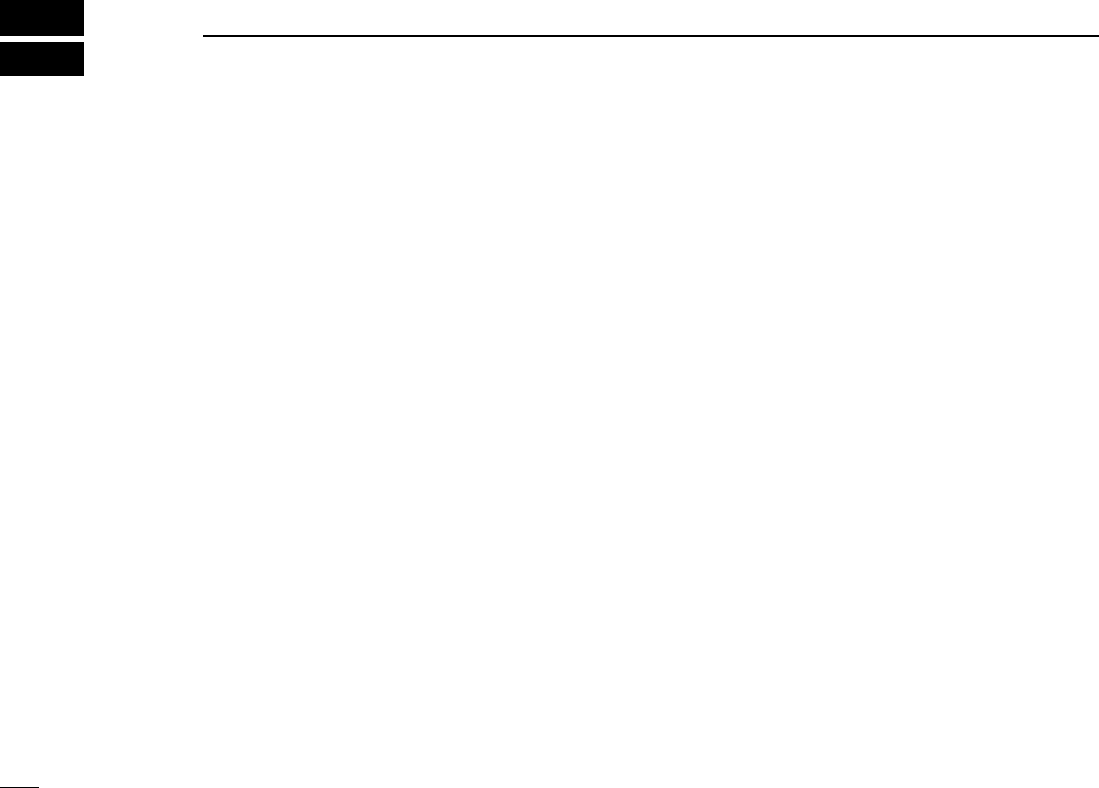
37
SPECIFICATIONS AND OPTIONS
New2001New2001
9
■Specifications
DDGENERAL
• Frequency coverage :0.010–3299.9999 MHz
*Guaranteed: 0.495–3000.000 MHz range only
• Type of emission : FM, AM, WFM, USB, LSB, CW
• Number of memory channels : 1050 (incl. 50 scan edges )
• Frequency resolution : 1 Hz, 10 Hz, 20 Hz, 50 Hz, 100 Hz,
500 Hz, 1 kHz, 2.5 kHz, 5 kHz, 6.25 kHz,
8.33 kHz, 9 kHz, 10 kHz, 12.5 kHz,
15 kHz, 20 kHz, 25 kHz, 30 kHz, 50 kHz,
100 kHz, 125 kHz, 150 kHz, 200 kHz,
500 kHz, 1 MHz, 10 MHz
• Operating temperature range : –10°C to +60°C; +14˚F to +140˚F
• Frequency stability : ±3 ppm (–10°C to +60°C)
• Power supply requirement : 12.0 V DC ±15%
• Current drain
(at 12.0 V DC: approx.) : standby 0.65 A (typical)
max. audio 1.2 A
• Antenna connector : BNC (50 Ω)
• Dimensions (proj. not included)
Receiver : 146(W) ×41(H) ×206(D) mm
53⁄4(W)×15⁄8(H)×81⁄8(D) in
Controller : 111(W) ×40(H) ×26.5(D) mm
43⁄8(W)×19⁄16(H)×11⁄32(D) in
• Weight (approx.)
Receiver : 1.2 kg; 2 lb 10 oz
Controller : 0.2 kg; 717⁄32 oz
DDRECEIVER
• Receive system : Triple-conversion superheterodyne and
down converter
• Intermediate frequencies : 1st: 266.700 MHz, 2nd: 10.700 MHz
3rd: 450 kHz (except for WFM mode)
• Sensitivity:
FM (1 kHz/3.5 kHz Dev.; 12 dB SINAD)
28.000–29.999 MHz : Less than 0.63 µV
30.000–49.999 MHz : Less than 0.63 µV
50.000–239.999 MHz : Less than 0.5 µV
240.000–279.999 MHz : Less than 0.5 µV
280.000–299.999 MHz : Less than 0.5 µV
300.000–699.999 MHz : Less than 0.5 µV
700.000–1299.999 MHz : Less than 0.63 µV
1300.000–2299.999 MHz : Less than 5.6 µV
2300.000–3000.000 MHz : Less than 18 µV
WFM (1 kHz/52.5 kHz Dev.; 12 dB SINAD)
50.000–699.999 MHz : Less than 1.4 µV
700.000–1299.999 MHz : Less than 1.8 µV
1300.000–2299.999 MHz : Less than 18 µV
2300.000–3000.000 MHz : Less than 56 µV
AM (1 kHz/30% MOD.; 10 dB S/N)
0.495–1.799 MHz : Less than 25 µV
1.800–14.999 MHz : Less than 2.5 µV
15.000–49.999 MHz : Less than 2.5 µV
50.000–299.999 MHz : Less than 2 µV
300.000–699.999 MHz : Less than 2 µV
700.000–1299.999 MHz : Less than 2.5 µV
! IC-R1500.qxd 05.10.21 10:07 AM Page 37 (1,1)

38
9
SPECIFICATIONS AND OPTIONS
1
2
3
4
5
6
7
8
9
10
11
12
13
14
15
16
New2001
SSB/CW (10 dB S/N)
0.495–1.799 MHz : Less than 5 µV
1.800–14.999 MHz : Less than 0.5 µV
15.000–49.999 MHz : Less than 0.5 µV
50.000–699.999 MHz : Less than 0.4 µV
700.000–1299.999 MHz : Less than 0.5 µV
• Sensitivity (threshold) :
FM (1 kHz/3.5 kHz Dev.; 12 dB SINAD)
28.000–29.999 MHz : Less than 0.63 µV
30.000–49.999 MHz : Less than 0.63 µV
50.000–239.999 MHz : Less than 0.5 µV
240.000–279.999 MHz : Less than 0.5 µV
280.000–299.999 MHz : Less than 0.5 µV
300.000–699.999 MHz : Less than 0.5 µV
700.000–1299.999 MHz : Less than 0.63 µV
1300.000–2299.999 MHz : Less than 5.6 µV
2300.000–3000.000 MHz : Less than 18 µV
WFM (1 kHz/52.5 kHz Dev.; 12 dB SINAD)
50.000–699.999 MHz : Less than 5.6 µV
700.000–1299.999 MHz : Less than 7.1 µV
1300.000–2299.999 MHz : Less than 71 µV
2300.000–3000.000 MHz : Less than 220 µV
AM (1 kHz/30% MOD.; 10 dB S/N)
0.495–1.799 MHz : Less than 18 µV
1.800–14.999 MHz : Less than 0.89 µV
15.000–49.999 MHz : Less than 0.89 µV
50.000–299.999 MHz : Less than 0.71 µV
300.000–699.999 MHz : Less than 0.71 µV
700.000–1299.999 MHz : Less than 0.89 µV
SSB/CW (10 dB S/N)
0.495–1.799 MHz : Less than 71 µV
1.800–14.999 MHz : Less than 7.1 µV
15.000–49.999 MHz : Less than 7.1 µV
50.000–699.999 MHz : Less than 5.6 µV
700.000–1299.999 MHz : Less than 7.1 µV
• Selectivity :
SSB/CW/AM More than 2.8 kHz/–6 dB (typical)
SSB/CW/AM/FM More than 6.0 kHz/–6 dB (typical)
AM/FM More than 15 kHz/–6 dB (typical)
AM/FM/WFM More than 50 kHz/–6 dB (typical)
WFM More than 230 kHz/–6 dB (typical)
• AF output power (at 12.0 V DC) : More than 0.5 W at 10% distortion with an 8 Ω
load
• Ext. speaker connectors : 2-conductor 3.5 (d) mm (1⁄8″)/8 Ω
• Data connectors : 2-conductor 3.5 (d) mm (1⁄8″)/100 K Ω
! IC-R1500.qxd 05.10.21 10:07 AM Page 38 (1,1)

39
11 SPECIFICATIONS AND OPTIONS
New2001
■Options
UT-106
DSP UNIT
W
SP-10
EXTERNAL SPEAKER
For all-round mobile operation. Cable length: 1.5 m; 4.9 ft
OPC-???
SEPARATION CABLE
For extended separate installation. 3.5 m (11.5 ft)
CP-12L/LR
CIGARETTE LIGHTER CABLES
F
OPC-254L
DC POWER CABLES
F
BC-???
AC ADAPTER
F
! IC-R1500.qxd 05.10.21 10:07 AM Page 39 (1,1)

40
11
CHAPTER CONTINUED
New2001
1
2
3
4
5
6
7
8
9
10
11
12
13
14
15
16
! IC-R1500.qxd 05.10.21 10:07 AM Page 40 (1,1)

1-1-32 Kamiminami, Hirano-ku, Osaka 547-0003, Japan
A-????-1EX
Printed in Japan
©2005 Icom Inc.
New2001
! IC-R1500.qxd 05.10.21 10:07 AM Page 41 (1,1)